PART I—
SCHOENBERG AND THE BRAHMS TRADITION, 1893–1897
Chapter One—
The "Brahms Fog":
A Context for Early Schoenberg
In a letter written in April 1894 to his friend Adalbert Lindner, the twenty-one-year-old Max Reger (1873–1916) staunchly defended Brahms against obstreperous journalistic opponents. Reger conceded that Brahms's music might at first be difficult to grasp, but noted:
Brahms is nonetheless now so advanced that all truly insightful, good musicians, unless they want to make fools of themselves, must acknowledge him as the greatest of living composers. . . . Even if Lessman takes such pains to disperse Brahms and the Brahms fog [Brahmsnebel ] (to use Tappert's term), the Brahms fog will remain. And I much prefer it to the white heat [Gluthitze ] of Wagner and Strauss.
REGER 1928, 39–40
Reger refers here to Otto Lessmann, editor of the Allgemeine Musik-Zeitung in Berlin from 1881 to 1907, and to Wilhelm Tappert, a prominent Wagnerian critic. I have not been able to locate where Tappert coined the term Brahmsnebel,[1] but it is not hard to see (or guess) what he—and Reger quoting him—may have meant by it. When paired with Reger's description of the "white heat" of Wagner and Strauss, Lessmann's phrase makes for an attractive characterization of the notorious dialectic that dominated Austro-German music in the later nineteenth century. Instead of the more common military metaphor— Brahmsians doing battle
[1] Until 1888 Tappert was a regular contributor to two music journals, the Leipzig Musikalisches Wochenblatt and the Berlin Allgemeine Musik-Zeitung. The term Brahmsnebel does not appear in any of his writings for these journals that I have been able to discover. Nor does it appear in his several books on Wagner.
with Wagnerians—one composer and his followers are seen shrouded in a cold, dense mist, the other group radiating intense warmth and light.
Most scholars (and performers) have been attracted more readily to the brighter glow, to the phenomenon of Wagnerism and post-Wagnerism in Europe at the end of the nineteenth century. There has been less appreciation of the extent to which the "Brahms fog" penetrated to the heart of Austro-German music during the same period. "Brahms is everywhere," Walter Niemann remarked in 1912 near the end of an article in which he had briefly surveyed no fewer than fifty European composers whose piano music he said bore the unmistakable traces of the master's influence (Niemann 1912, 45). Hugo Leichtentritt observed similarly that "from about 1880 all chamber music in Germany is in some way indebted to Brahms" (Leichtentritt 1963, 449). The comments of Niemann and Leichtentritt could be applied equally to the vast quantities of Lieder issued by German and Austrian publishing houses in the same years.[2]
Perhaps as never before in the nineteenth century did young composers in German-speaking lands adhere so closely—and so proudly—to a single model when working in these genres. Reger could actually boast to Lindner in 1893 that "the other day a personal friend of Brahms's mistook the theme from the finale of my second violin sonata [op. 3] for a theme from one of Brahms's recent works. Even Riemann [Reger's teacher] told me that I really know Brahms through and through" (Reger 1928, 33).[3] Other testimony to Reger's Brahms-Begeisterung comes from the music critic Leopold Schmidt:
What brought us together was our joint enthusiasm [Schwärmerei] for Brahms. At that time this feeling was stronger in Reger than even his undenied love for Bach. He saw in Brahms a protector, a figure who could fight against the "program music" that he [Reger] so hated, against everything that had no form, no limits. At that time there was no trace of the easygoing manner one could observe in the later Reger. Especially over a glass of wine, he could become absorbed in long, serious conversations.
[2] Although there has been some investigation of individual Nachfolger of Brahms (mostly in routine life-and-works accounts, such as Deggeller-Engelke 1949, Holl 1928, and Kohleick 1943), nowhere do we get a genuinely critical or comparative account of Brahms's reception among composers of the period: of how his music affected that of his followers. Comprehensive bibliographies of Brahms-Forschung, arranged topically, may be found in Fellinger 1983, 192–96, and id., 1984, 203–6.
And his eyes would always shine brighter as soon as the discussion came around to "our Johannes."
SCHMIDT 1922, 160
Arnold Schoenberg would also in later years acknowledge his early admiration for and emulation of Brahms, not (as far as we know) over a glass of wine, but in essays, textbooks, and the classroom.[4] His earliest compositions also bear proud witness to this phenomenon. In the years through 1897, Schoenberg's works fall squarely into the three Brahmsian genres mentioned above: piano music, Lieder, and chamber music. From the point of view of style and technique, too, these works are very much enveloped in a Brahmsian fog. Evaluating and analyzing Jugendwerke like these compositions—the task of chapters 2 and 3 of the present study—gives rise to certain methodological problems. When a young composer turns to a powerful model, his works often become interesting more for what they reveal of his response to and assimilation of the model than for their own inherent aesthetic qualities. Study of such works may tend more toward reception history than to musical analysis. In the best music criticism, of course, the two endeavors should not be separated: a composition cannot easily be understood in isolation from its context, from its influences. In the commentary that forms the bulk of the next two chapters, I shall try to strike a balance between the two approaches—between an appreciation of the ways in which Schoenberg's earliest music is indebted to Brahms and an assessment of its more intrinsic qualities and merits.
In this regard it is worth letting the composer himself speak. The later Schoenberg would probably have been impatient with much of the Brahmsian imitation evident in his own early works and in those of other composers enveloped in the "Brahms fog." He had little respect for the imitation of a "style" in this sense, as he noted in an essay of 1934: "To listen to certain learned musicians, one would think that all composers did not bring about the representation of their vision, but aimed solely at establishing a style—so that musicologists should have something to do." Schoenberg felt that a work's "personal characteristics"—the style manifest in it—are merely "symptoms" laid over the essential "idea": "To overlook the fact that such personal characteristics follow from the true characteristic idea and are merely the symptoms—to believe, when someone imitates the symptoms, the style, that this is an artistic achievement—that is a mistake with dire consequences!" (Schoenberg 1975, 177–78).
[4] Schoenberg's 1947 essay "Brahms the Progessive" (Schoenberg 1975, 398–441) is only the most famous of his numerous appreciations of Brahms. See my own discussion of Schoenberg's Brahms-Kenntnis in Frisch 1984, 1–18. A comprehensive account is Musgrave 1980.
This formulation—style versus idea—was central to Schoenberg's thought throughout much of his life, and, of course, it furnished the title for his collected essays, Style and Idea, in 1950.[5] It also furnished the ostensible justification for much of his music, in which he often resolutely refused to follow any "style." But a young composer—perhaps especially a self-taught one like Schoenberg, whose only textbooks were scores, whose principal teachers were the great masters—will almost always forge his own style out of that of an important predecessor or contemporary.[6]
Something like the style/idea distinction can be a valuable heuristic tool in understanding the early works of Schoenberg and his contemporaries. There are composers and works that seem clearly more caught up in trying to "sound" like Brahms on a superficial level (the "style"); and there are those that try to plumb Brahmsian depths by employing more subtle technical and expressive devices (the "ideas"). As a preliminary to examining Schoenberg's early works, it will be useful to assess a small control group of Brahmsian pieces composed by two of his most talented contemporaries, Zemlinsky and Reger, from these perspectives. Although the sample cannot claim to be objectively "representative" (whatever that may mean in the aesthetic realm), it may nevertheless serve to shed light on the Brahmsian context from which Schoenberg emerged.
Zemlinsky
Alexander von Zemlinsky (1872–1942), who in the period 1895–97 or 1896–97 became Schoenberg's only teacher in composition (we can be sure of neither the
[5] Schoenberg fought hard to retain this title, about which the original publishers at Philosophical Library were not enthusiastic (see McGeary 1986, 184–88). The concept of a musical "idea," which Schoenberg reformulated many times, was to find its most complete exposition in a large manuscript, which remained unfinished, entitled "Der musikalische Gedanke und die Logik, Technik und Kunst seiner Darstellung." A scholarly edition of this work, the so-called Gedanke manuscript, will appear as Schoenberg 1994. For a survey of its contents, see Goehr 1977. On the various possible meanings of "idea" in Schoenberg's writings, see Cross 1980.
[6] It is possible that Schoenberg's strong reaction against "style" as both a creative tool and critical yardstick was owing to his proximity in Vienna to the music historian Guido Adler (with whom he actually shared students, including Webern and Wellesz). Adler's highly influential methodological studies (see, for example, Adler 1911) form part of a much broader phenomenon of style consciousness among both practitioners and critics of the arts at the end of the nineteenth century. In German-speaking areas, especially, the visual arts and architecture were dominated by the notion of Stilkunst and of art having its own "will to style" (Stilwollen). In art history these concepts were given their strongest formulation by the Viennese curator and writer Alois Riegl, whose ideas are discussed by Schapiro (1953, 301–2) and Alpers (1987, 140–47); Riegl had a powerful influence on his compatriot and contemporary Adler. There is no evidence of animosity on Schoenberg's part toward Adler's method. (On the relationship and surviving correspondence between Schoenberg and Adler, see Reilly 1982, 99–100.) The composer may nevertheless later have felt that the contemporary obsession with "style" was excessive and misdirected.
exact dates nor the content of the instruction), was one of the most promising young musicians in Vienna in the the last decade of the century. After an auspicious study period at the Conservatory under such Brahms cronies as Anton Door and Robert Fuchs, he served as a conductor in several Viennese theaters and opera houses (including a stint under Gustav Mahler at the Hofoper in 1907) and was widely admired as pianist and accompanist. In 1911 he moved to Prague as opera director of the German theater.[7]
In his early Viennese period, Zemlinsky was fully, and willingly, enveloped in the "Brahms fog." In his brief memoir of Brahms, he reports: "I remember how even among my colleagues it was considered particularly praiseworthy to compose in as 'Brahmsian' a manner as possible. We were soon notorious in Vienna as the dangerous 'Brahmins'" (Zemlinsky 1922, 70). Zemlinsky recalls that he had first been introduced to the master in 1895.[8] In the following year, Brahms took enough interest in a string quintet by Zemlinsky to invite the younger composer around to his apartment to discuss it (a devastating experience, described vividly in Zemlinsky's memoir). Shortly thereafter, at a competition of the Wiener Tonkünstlerverein, Zemlinsky's Clarinet Trio in D Minor won the third prize, for which Brahms himself had put up the money. This time, Brahms thought highly enough of the composition to recommend it to his own publisher, Fritz Simrock, in a letter that also praised Zemlinsky as "a human being and a talent" (Brahms 1908–22, 4: 212). Simrock issued the Clarinet Trio as Zemlinsky's op. 3 in 1897.
The period of Zemlinsky's personal contact with Brahms and of his most ardently Brahmsian works coincided directly with the beginning of his own relationship with, and instruction of, Schoenberg. These compositions thus merit careful consideration by anyone interested in Schoenberg's early development.[9] It is striking that the compositions of the more accomplished and highly trained Zemlinsky, although echt- Brahms in "style," actually show less real understanding of Brahms than the best works by the more intuitive, largely self-taught Schoenberg. We can see this phenomenon better by examining a small sampling—one song and one movement of a string quartet—from Zemlinsky's Brahms period.
Zemlinsky was proud enough of the song Heilige Nacht to place it at the head of his first collection of Lieder, op. 2, published in 1897 (see ex. 1.1). The anonymous poem, a hymn of praise to night, which covers everything in a cloak of
[7] For further biographical information on Zemlinsky, see Weber 1977.
[8] The occasion was the premiere of Zemlinsky's Orchestral Suite at a concert of the Gesellschaft der Musikfreunde on 18 March. Brahms led his own Academic Festival Overture in the same program. The event is described in Kalbeck 1904–14, 4: 400–401.
[9] A recent comprehensive study of Zemlinsky's early chamber works is contained in Loll 1990.
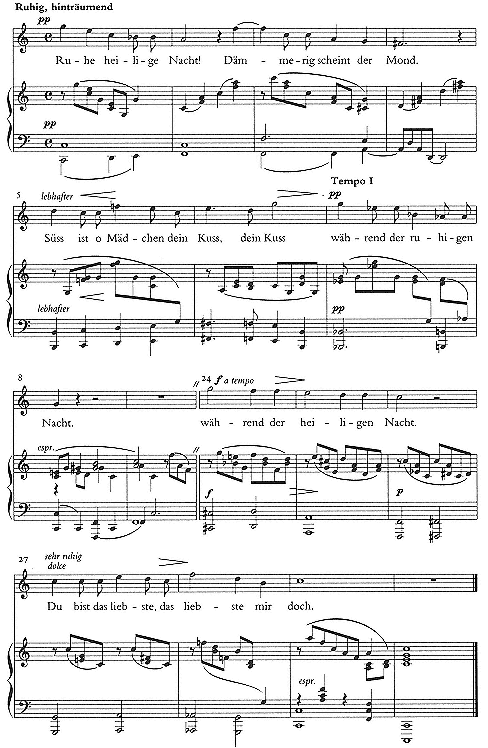
Example 1.1
Alexander von Zemlinsky, Heilige Nacht , op. 2, no. 1.
tranquility ("even sorrow is sweet"), is of a type that attracted Brahms strongly.[10] The characteristics of Zemlinsky's song that derive from Brahms are (to this listener) so palpable that they can be itemized:
· the broad, descending triadic melody, mm. 1–4. Cf. Brahms's Sehnsucht, op. 49, no. 3, where the slow ascending arpeggios of the opening are inverted in the faster middle section. There are also ascending arpeggios at the opening of Wie Melodien zieht es mir, op. 105, no. 1, and Maienkätzchen, op. 107, no. 4.
· the strong, stepwise bass line, especially in mm. 1–6. Cf. Dein blaues Auge, op. 59, no. 8.
· the arpeggiated figuration in the right hand of the accompaniment, which is shaped as a diminution of the vocal rhythm and motives, mm. 1–8. Cf. Mein wundes Herz, op. 59, no. 7. (On this technique of "harmonic congruence," see Cone 1990.)
· the dip toward the subdominant at the very beginning, mm. 1–2. Cf. An ein Veilchen, op. 49, no. 2, where, however, the tonic root remains in the bass underneath the subdominant triad. (See also the discussion of sub- and pre-dominant chords in Brahms's intermezzi below.)
· the sudden move by third, from a G to an





· the extension or augmentation of "während der heiligen Nacht" to create an irregular three-measure phrase, mm. 24–26. Cf. the augmentation of the phrase "tonreichen Schall" in An die Nachtigall, op. 46, no. 4, mm. 5–7.[11]
· the strong plagal cadence at the end of the song, mm. 29–30. Cf. the final cadence of Die Mainacht.
[10] At least twelve of Brahms's works are set to such texts, including (in alphabetical order) Der Abend, op. 64, no. 2; Abenddämmerung, op. 49, no. 5; Abendregen, op. 70, no. 4; An den Mond, op. 71, no. 2; Dämmrung senkte sich von oben, op. 59, no. 1; Gestillte Sehnsucht, op. 91, no. 1; In stiller Nacht, WoO 33, no. 42; Die Mainacht, op. 43, no. 2; Mondenschein, op. 85, no. 2; Mondnacht, WoO 21; O schöne Nacht! op. 92, no. 1; and Sommerabend, op. 85, no. 1.
[11] This and other examples of such phrase extension in Brahms's songs were pointed out admiringly by Schoenberg in "Brahms the Progressive" (Schoenberg 1975, 418–22).
Despite the distinguished, documentable pedigree of its technical devices, Zemlinsky's Heilige Nacht comes across as a pallid imitation of the master. First, the phrase structure is uncomfortably square. The rather rigid succession of two-measure units in the opening section, through m. 8, is scarcely concealed by the small modifications, such as in m. 6, where Zemlinsky repeats the words "dein Kuß" in order to extend the phrase another half measure. There is little here of the subtle asymmetry fundamental to Brahms's language. Nor would Brahms himself have undermined what is supposed to be a magical moment, the shift to the

Despite its apparent resemblance to Brahms, the harmonic syntax of Heilige Nacht also betrays awkwardness. Instead of an inflection toward the subdominant such as we might find in a Brahms song, the IV chord in m. 2 appears in root position; it is too emphatic, bringing the harmonic motion to a virtual standstill. Zemlinsky's actual cadence to F in mm. 8–9, though perhaps intended as a fulfillment of the opening harmonic gesture, is also unconvincing. The tonic has barely been reestablished in m. 7 when it is transformed into an augmented chord that is made to function as a dominant. The augmented sonority with an added seventh sounds especially bizarre in the prevailingly consonant context.
If I seem to be too hard on what is in many outward respects an attractive song, it is to point up that Zemlinsky is good at appropriating superficial stylistic traits from Brahms without really absorbing his fundamental compositional principles. This aspect of Zemlinsky's musical personality was recognized by Theodor Adorno, who in his penetrating essay of 1959 suggests that Zemlinsky was a genuine eclectic, "someone who borrows all possible elements, especially stylistic ones, and combines them without any individual tone" (Adorno 1978, 351). Adorno tries to strip the term eclectic of its pejorative connotations, arguing that Zemlinsky was in fact something of a genius in his "truly seismographic capacity to respond to all the temptations with which he allowed himself to be inundated" (354). I would argue that this "seismographic" receptivity actually prevented Zemlinsky from absorbing the essence of Brahms. He registered the aftershocks, so to speak, but failed to locate the epicenter of the tremor.
The same tendency can be seen in the first movement of Zemlinsky's String Quartet in A Major, which was published by Simrock as op. 4 in 1898. In the
[12] See, e.g, the perceptive analysis of such techniques in the song Feldeinsamkeit in Schmidt 1983, 146–54.
first group (ex. 1.2), the notated meter








In his commentary on this movement, Rudolf Stephan has suggested that "rhythmic complications of this kind point to the model of Brahms, who, however, does not employ them in this (almost) systematic fashion" (Stephan 1976, 128). The parenthetical "almost" betrays an appropriate diffidence, for I would maintain that there is little that is truly systematic in Zemlinsky's procedures. Indeed, it is Brahms who is more "systematic," if also more restrained, as can be shown by a brief comparative glance at the first movement of his Third Quartet in





To return for a moment to Zemlinsky's A-Major Quartet: Brahmsian symptoms are also evident in the ostentatious invertible counterpoint in mm. 5–6 and 7–8, and especially in the way in which the cadential neighbor-note motive of m. 4 (ex. 1.2) is taken up again in the transition to the second group (ex. 1.4). Here the motive, which sounds in


Brahms is the direct inspiration for this whole procedure. Indeed, Zemlinsky must have had the first movement of the Second Symphony in his ears: his neighbor-note figure bears a distinct resemblance to Brahms's basic motive,


Example 1.2
Zemlinsky, String Quartet No. 1 in A Major, op. 4, 1.
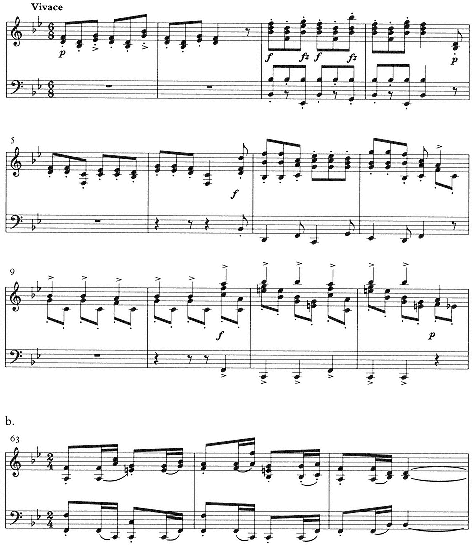
Example 1.3
Johannes Brahms, String Quartet No. 3

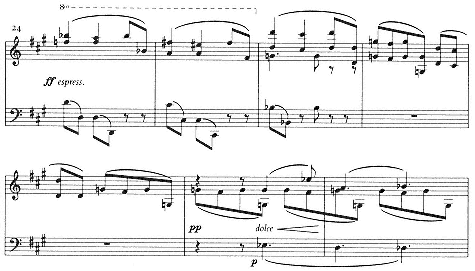
Example 1.4
Zemlinsky, String Quartet No. 1 in A Major, op. 4, 1.
the neighbor-note figure and its triadic companion in diminution and then moves the latter into the background to become the accompaniment for the new theme. At precisely the analogous moment in the sonata form, Zemlinsky adopts this same technique using the neighbor-note motive.
The conclusion to be drawn from these analyses may seem self-evident: no one could compose Brahms as well as Brahms himself. But I am suggesting that a superbly equipped composer like Zemlinsky can actually manage to sound very like Brahms—as he put it, "to compose in as 'Brahmsian' a manner as possible"—without showing a deeper grasp of what "Brahmsianness" really is or could be.
Reger
Like Zemlinsky, the young Reger wrote his share (more than his share) of pieces that imitate many of the master's "symptoms."[13] But there is also one brief, and for Reger rather restrained, work that does something more (and less). It is a short piano piece written after Brahms's death on 3 April 1897 and intended specifically as a memorial tribute. Reger published it in 1899 as op. 26, no. 5, with
[13] On the Reger-Brahms relationship, see especially Wirth 1974.
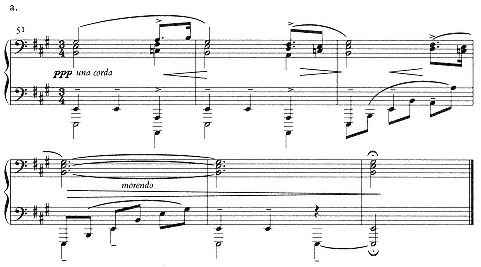
Example 1.5
Max Reger, Resignation , op. 26, no. 5.
the title Resignation and the subtitle 3 April 1897—J. Brahms† .[14] As a tombeau specifically intended to evoke the departed master, Resignation can hardly be taken as representative of Reger's work, or of that of other composers in the "Brahms fog" of the decades around 1900. Yet it shows perhaps better than any other individual work the different ways in which Brahms could be "received" compositionally.
We may distinguish four levels or degrees of Brahms reception in Resignation. Arranged in order from the most obvious or blatant to the most subtle, these might be called quotation, emulation, allusion, and absorption. The piece concludes with a direct, clear quotation of the theme from the Andante of Brahms's Fourth Symphony (ex. 1.5a). The reference could not be more patent; Reger even derails the tonic of Resignation, which up to this point has been A major, in order to bring the final quotation into its original key, E major, thus ending Resignation in the dominant!
[14] Resignation has a kind of companion piece, entitled Rhapsodie and subtitled Den Manen Brahms (To the Memory of Brahms), which is a large, turbulent work modeled closely on Brahms's Rhapsodies, op. 79. It was published in 1899 as Reger's op. 24, no. 6. Both pieces are discussed briefly by Lindner 1938, 165, who notes their "strongly Brahmsian stamp." Both are printed in Reger 1957, where the editor, Helmut Wirth, attributes them to the summer of 1898, even though the autographs bear no dates. I suspect that at least Resignation may have been written a year earlier, perhaps just after Reger heard about Brahms's death.
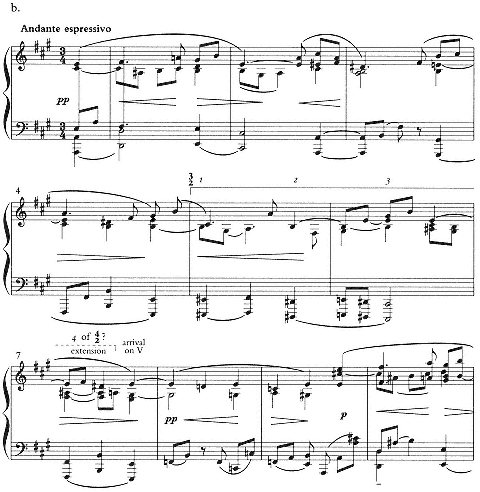
Example 1.5
continued
The body of the piece that precedes this coda shows a considerable degree of emulation, by which I mean a general stylistic imitation of what Schoenberg would call the "symptoms." Such broader features of Brahms's piano style were aptly described by Niemann in 1912 as "motion by thirds and sixths, their orchestral doublings, the preference for wide spacings and for a sonorous, dark, low register, [and] a self-willed rhythmic language, with a tendency toward syncopated and triplet figures of all kinds" (Niemann 1912, 39). Reger's Resignation clearly strives for this more superficial kind of emulation, as can be seen in ex.
1. 5b, which presents the opening portion of the piece. (The overall ABA' form of Resignation is also typical of Brahms's late piano works.)
But Reger also goes beyond emulation to allude more specifically to at least three late Brahms intermezzi that share the two keys of Resignation: op. 116, nos. 4 and 6, both in E major; and op. 118, no. 2, in A major (see exx. 1.6a-d). Reger's deep bass octaves recall 1.6b; the distinctly polyphonic texture, with active middle voices, is a feature of both 1.6a and c. Reger also adopts the opening gesture characteristic of all three intermezzi: Resignation begins on an upbeat with a root-position tonic chord, which moves on the subsequent downbeat to a predominant sonority, ii6 . Brahms uses similar harmonies on the downbeat: in ex. 1.6a, vi6 ; in ex. 1.6b, first a passing chord on A, then ii; and in ex. 1.6c, a

In Reger, as in exx. 1.6a and b, the precise configuration of the pre-dominant chord is obscured by appoggiaturas and (as in 1. 6a) by the holding of notes over the bar line. These rhythmic and/or melodic devices serve in each case to create harmonic ambiguity: we do not know whether to interpret the first chord as a tonic or as V of IV. In ex. 1.6b, Brahms also generates considerable metrical ambiguity. Our ear tends to hear the strong root-position chord as a downbeat, and the subsequent phrasing suggests a broad


At the approach to the dominant in Resignation, mm. 6–9, Reger draws upon precisely these kinds of metrical ambiguity or conflict. As we listen—at least for the first time—mm. 5–6 suggest a







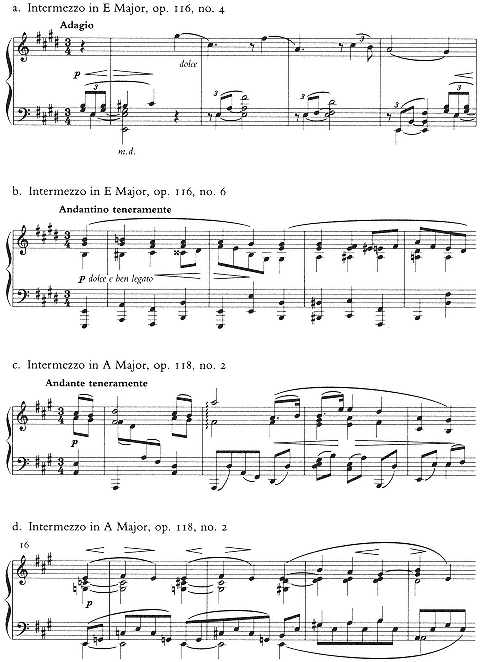
Example 1.6
Brahms Intermezzi.
ian gesture: the A enters a half-beat too "early," sounding deep in the bass underneath the prevailing dominant harmony.[15]
The elegant procedures involving meter, harmony, and phrase structure that I have analyzed in mm. 6–9 of Reger's Resignation fall into the last, most subtle category, absorption. Reger is making no apparent quotation of, or allusion to, any specific passage in Brahms; rather he has fully internalized some of Brahms's most characteristic compositional techniques. This is the kind of "influence" that Charles Rosen has characterized as the most profound, and also the least easily detected: no precise model can be found, and the search for one becomes essentially an endeavor of "pure musical analysis" (Rosen 1980, 100).
Resignation obviously appeared too late to have served as any kind of model for Schoenberg's early Brahms assimilation. A further investigation of possible "influence" in this traditional sense would have to examine the works of Reger that appeared before 1897, thus his opp. 1–16 (1893–96). (Unlike in the case of Zemlinsky's music, where we can assume that Schoenberg would have been familiar with works composed or published in the mid 1890s, we cannot be sure just what early Reger works Schoenberg might have known.) My point in examining Resignation has not been to claim that Reger served as model for Schoenberg, but rather to suggest how Brahms may really have served as model for them both. Even at its most "symptomatic," a work like Resignation can show deeper points of contact with the compositional essence of Brahms, as in mm. 6–9. It is this kind of absorption, rather than the more superficial imitation evident in some of the Zemlinsky works, toward which the young Schoenberg strove; this will be the essential subject of the next two chapters.
[15] Although I have found no specific instance of this procedure in Brahms's piano music, the overlapping of dominant and tonic at moments of return occurs in a variety of ways in the orchestral and chamber music. See Frisch 1984, 138–39, for a discussion of this procedure in the Andante of Brahms's Third Symphony.
Chapter Two—
The Instrumental Works
A substantial number of compositions, both instrumental and vocal, survive complete from Schoenberg's Brahmsian period; there are also many fragments and torsos. Because some of the works and most of the fragments were not dated by the composer and are not firmly datable by either internal musical or external biographical means, it is impossible to construct anything like a definitive chronology. But a survey of the surviving juvenilia suggests that it was through his assimilation of Brahms that Schoenberg really began to grow as a composer.[1]
This process started at least as early as 1893, with the first datable Lieder, was well under way with the Piano Pieces of 1894, and culminated in 1897 with two Lieder based on poems by Paul Heyse (to be examined in chapter 3) and the D-Major String Quartet. The principal instrumental compositions of Schoenberg's early period through 1897, not including the smaller fragments, are listed in table 1.[2] In this chapter we trace an ever more sophisticated assimilation of Brahmsian principles across three of the main works, the Piano Pieces of 1894 (and a fragmentary scherzo probably composed at the same time), the Serenade of 1896, and the D-Major Quartet and F-Major Scherzo for Quartet of 1897.
[1] Biographical information on Schoenberg's early years is scarce. Aside from such standard secondary sources as Stuckenschmidt 1978 and valuable but brief memoirs like Zemlinsky 1934 and Bach 1924, Schoenberg's 1949 essay/lecture "My Evolution" (in Schoenberg 1975, 79–92) is the best known and most often cited account of his youth. See also the autobiographical remarks in Schoenberg's 1949 "Notes on the Four String Quartets" (in Rauchhaupt 1971, 35–36).
[2] The most extensive inventory of compositions and fragments from this period is given in Maegaard 1972, 1: 26–28 and 147–66. In compiling his catalogue from materials in the United States (mainly in the Schoenberg Nachlaß in Los Angeles), Maegaard did not have access to the Nachod collection (originally from Schoenberg's brother-in-law Hans Nachod), which is now at North Texas State University and is catalogued in Kimmey 1979. More recently, a small portion of the Nachod collection that had been retained by the last private owners has come into the possession of the Arnold Schoenberg Institute.
| ||||||||||||||||||||||||||||||||||||
The Three Piano Pieces and Scherzo of 1894
As I have suggested elsewhere, a symphony theme cited by Schoenberg as having been written by him in about 1892 already shows a familiarity with Brahms's Tragic Overture specifically, and with Brahms's procedures of thematic evolution more generally (Frisch 1984, 159). Schoenberg's Three Piano Pieces of 1894 (printed complete in SW A4: 73–83), the first substantial instrumental compositions that survive, show that the twenty-year-old composer had continued to study Brahms intensively—in this case, the short piano works published recently in Brahms's collections opp. 116, 117, 118, and 119 (1892–93).
What is striking in the first of Schoenberg's 1894 pieces, an Andantino in





eighth note "early" on the notated downbeat of m. 10. Although notated and perceived downbeats coincide here, the


The last two sixteenth notes of m. 10 hover uneasily in a kind of metrical void: they sound neither like the last beat of a





Schoenberg's complex metrical procedures derive directly from Brahms, who often shifts the entire framework by a beat so that notated and perceived meters are out of phrase for long stretches.[3] But in his almost single-minded concentration on the metrical dimension of the music, Schoenberg tends to leave the others underdeveloped. The harmonic language of the Andantino remains very conventional, as does the basic phrase structure. Despite the metrical blip in mm. 9–11, the whole first section of the piece, up to the double bar, comprises four phrases in

In Schoenberg's Andantino, mm. 1–3 constitute the first statement, beginning and closing on the tonic; mm. 4–6 are the "complementary repetition," beginning on the tonic and moving to III;[4] mm. 7–12, comprising twice as many measures as each of the preceding parts, are the developmental continuation and
[4] In Schoenberg's formulation (1967, 21–24) the second phrase is called the "dominant form," normally beginning on V (his locus classicus is the opening of Beethoven's Piano Sonata in F Minor, op. 2, no. 1). He also acknowledges other possible harmonic schemas, including beginning the second phrase on the tonic and concluding it in a contrasting key.

Example 2.1
Schoenberg, Piano Piece in

conclusion (ending on VI). Schoenberg observes in Fundamentals of Musical Composition that the "development" in the last portion of a sentence usually consists of reducing the thematic material to its smallest components, a process he calls "liquidation" (1967, 58). Liquidation is lacking in the piano piece, however: the basic three-measure unit (in notated measures) remains essentially intact and is given two full presentations in mm. 7–12.[5] What is "developed" is clearly the metrical aspect: the "early" arrival in m. 10 and the mysterious "extra" beat at the end of the same measure constitute the most dramatic changes in the basic unit.
Like many of Brahms's short pieces, and like Reger's Resignation, the Andantino has a ternary form; in this instance the middle section (mm. 13–26) serves as a kind of development of the opening material. As in mm. 7–12, the development is primarily metrical in nature. Indeed, it is the same





Schoenberg varies the return of the opening section in m. 27 (ex. 2. 1): the main theme now appears in canon between the two hands, decorated with an inner part moving in triplets. The canon here serves not purely as a contrapuntal variation of the material, but as further metrical manipulation, which now obscures both the notated and perceived frameworks.
Schoenberg's Andantino, then, can be said to adopt certain outward "symp-
toms" of Brahms's style, evident in the arpeggiated bass and in the piano texture in general, and one more specific technical aspect, that of metrical development. But the piece may be said to founder precisely because the areas of motivic development, harmony, and phrase structure are not treated at the same level as, and are not adequately coordinated with, the metrical procedures (as happens, for example, in the first movement of Brahms's

In these respects the third of the piano pieces, a Presto in A minor, is more ambitious and, it might be said, more successful. In his brief memoir of Schoenberg's youth, David Josef Bach makes the intriguing remark that "with its remarkable rhythm" this piece "already contains the seed of the later Schoenberg" (Bach 1924, 318). Unfortunately, Bach specifies neither what aspect of its rhythm is remarkable nor what prefigures the later Schoenberg. But he is right to imply that the piece is the most advanced of the three.
The progressiveness is not apparent in the phrase structure, which, as in the Andantino, is in itself quite square. The opening eight measures (ex. 2.2a) form what Schoenberg calls a "period" (Schoenberg 1967, 25–31), comprising a fourmeasure phrase and its varied restatement, or what we can call an antecedent and a consequent. (A period generally has two phrases of equal length, unlike a sentence.) In the Presto, both antecedent and consequent end on the dominant; the antecedent begins on the tonic, the consequent on a diminished seventh. The progressive aspect consists of the way this traditional design is filled out with chromatic harmony, specifically with what Schoenberg would later call "vagrant" chords (Schoenberg 1978, 134, 257–67); these are harmonies, such as diminished or half-diminished ones, that are ambiguous and can be led in different directions. Although the tonic is clearly implied by the bass in the first half of m. 1, it is nevertheless obscured by the right-hand arpeggiation of the diminished triad,


Brahms is an obvious source for this kind of controlled, intense chromaticism, as, for example, in the Capriccio, op. 116, no. 3, where the tonic G minor is continually subverted until the end of the A section.[6] The Brahmsian pedigree of the Presto is even more evident in Schoenberg's striving to make the entire tex-
[6] Thieme 1979, 81–82, has pointed to the importance of Brahms's Capriccio, op. 76, no. 1, as a model for the texture and figuration of the middle section of Schoenberg's Presto.
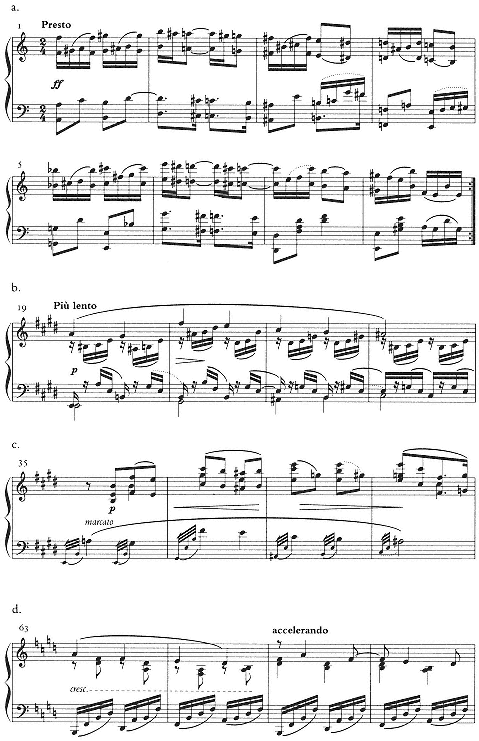
Example 2.2
Schoenberg, Piano Piece in A Minor (1894).
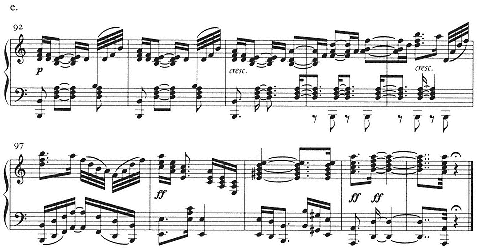
Example 2.2
continued
ture "thematic." The alto inner voice of the B section is derived from the main theme of the A section (ex. 2.2b). Later, the B theme moves into the bass and is presented simultaneously in diminution in the right hand (ex. 2.2c).[7]
The middle section lies in the key of the dominant; but Schoenberg avoids any strong cadential V-i motion at the return to the A. Instead, the return is made via the half-diminished ii7 chord, a vagrant harmony that is sustained for ten measures (mm. 63–72) by means of the energetic working of a descending motive A-F-E-D (ex. 2.2d).[8] The coda (mm. 92–101; ex. 2.2e) is built from the same harmony and motive; the motive is now compressed or diminuted even further and is subject to rhythmic displacement similar to that used in the Andantino in


[7] For the first procedure, see, for example, the first movement of Brahms's Second Symphony, where the arpeggio of the first theme forms (in diminution) the accompanying inner part to the second theme (as mentioned in the previous chapter). For the second, see Brahms's song Mein wundes Herz, op. 59, no. 7, where both voice and accompaniment are derived from the same material.
acts as the transformational beat, and the notated meter returns on the first beat of m. 97. The final cadence to the tonic in mm. 100–101 is made not via the dominant, but from a final appearance of the half-diminished (now in first inversion).
The intensity with which the ii7 chord is manipulated, both motivically and harmonically, suggests something of the later early Schoenberg: in the next chapter we shall see him exploiting the same sonority throughout the song Mädchenfrühling (1897). Yet because the phrase structure tends to remain four-square (even the B section unfolds in rigid four-measure units) and because the melodic invention is less than inspired, our final impression is one of a rather static, undevelopmental form.
A more fluid and sophisticated approach to phrase structure is evident in an eighty-measure fragment in

The first contrasting theme begins with this measure of tonic (not with the preceding dominant) and, like the main theme, consists of two parallel groups of eight measures. The first (mm. 18–25) moves from the tonic to its relative major, A, the second (mm. 25–32) back to the dominant. But these groups overlap, so that the final measure of the first (m. 25) is also the initial measure of the second. The ambiguity is heightened by the initial measure of each phrase (18 and 25), which remains in a sense athematic: the principal motive appears only in the second measure (19 and 26). The result is that m. 18 tends to sound like an introduction and m. 25 like a transition, even though these measures form an integral part of the overall phrase structure.
Thus, although they add up to an even number on the largest scale, the first thirty-two measures of the scherzo do not divide squarely into 8+4, as tends to
[9] See Maegaard 1972, 1: 149. The piece, edited by Reinhold Brinkmann, is published in SW B4:101–4.
happen in the Three Pieces of 1894. Rather, the "extra" measure, m. 17, and the compensating overlapping measure, m. 25, make the internal division asymmetrical:
MAIN THEME
Unit 1: mm. 1–8
Unit 2: mm. 9–16
"Extra" measure: m. 17
FIRST CONTRASTING THEME
Unit 1: mm. 18–25
(Overlapping measure: m. 25)
Unit 2: mm. 25–32[10]
Within the contrasting theme, the motivic working seems more fluid than in the other pieces of 1894. In the first phrase (mm. 18–21), as we have seen, the basic motive appears in the second measure (accompanied by figuration derived from m. 2 of the main theme) and then is rhythmically augmented and transformed across the third and fourth (20–21). In the second phrase the motive appears in the first two measures (22–23), but is absent from the cadential motion of the second two (24–25). The two phrases are thus not simply parallel, as is often the case in the piano pieces of 1894.
Serenade for Small Orchestra (1896)
In 1895 Schoenberg joined the small amateur orchestra Polyhymnia as cellist. It may well have been for this group that he began to compose what appears to be his first large-scale instrumental work, the Serenade in D Major. Schoenberg completed only the first movement; a scherzo, slow movement, and finale survive as fragments. The first movement is dated 1 September 1896 on the first page and 3 September on the last. The scherzo was begun on 30 November. The slow movement and finale bear no date.[11]
[10] By repetition Schoenberg extends the cadence past m. 32; the first theme reappears in m. 38.
[11] The slow movement fragment (microfilm no. U265–67 at the Schoenberg Institute), which bears no date, has not previously been identified as belonging to the Serenade. Maegaard 1972, 1: 26, includes only the other three movements in his entry for the Serenade; the slow movement is described on p. 152 as a separate work. Thieme 1979, 94, also identifies only three movements. Although it is not dated, the Andante clearly belongs to the Serenade. It has the same instrumentation as the other movements. It also has similar handwriting and is copied on the same kind of 28-stave paper as the scherzo movement (the other two movements are on 24-stave paper).
The orchestral serenade was a popular medium within the Austro-German-Bohemian sphere in the last decades of the nineteenth century. Schoenberg would surely have been acquainted not only with the two early serenades of Brahms (opp. 11 and 16), but also with more recent ones by Robert Volkmann, Antonin Dvorak[*] , Josef Suk, and Robert Fuchs. A well-worn score of Fuchs's Serenade for Strings in D Major, op. 9 (published 1874), filled with performance indications in an unidentified hand, survives in the archives of the Schoenberg Institute. This may well have been a score used by Polyhymnia and may also have provided inspiration for Schoenberg's own work in the same key. For his first movement, however, he found a more compelling structural-technical model in Brahms, and in particular in the first movement of Brahms's Second Symphony, also in the key of D major.
The overall design of Schoenberg's movement owes little directly to Brahms; it takes the form of a small-scale and somewhat oddly proportioned sonata, with a very brief exposition (mm. 1–12), consisting of a single long phrase moving from tonic to dominant; a substantial modulatory development (13–44); a conventional recapitulation (45–58); and a lengthy coda (58–77).[12] But the actual thematic ideas and their treatment are strikingly close to Brahms's first movement. Both movements begin with a theme (marked a in ex. 2.3a) in the low strings (violas in Schoenberg, cellos in Brahms) consisting of a neighbor-note figure that surrounds the tonic; the theme falls to the dominant note A. Unlike Brahms, however, Schoenberg accompanies this theme from the outset with a repeated rhythmic figure in the woodwinds (marked b). After two bars (one in Brahms), a new triadic idea (c) enters above motives a and b. This theme is treated imitatively by the violins while being accompanied continuously by the other two ideas. At the climax of the short exposition, the violin theme takes on the rhythm of motive b.
What is especially distinctive here is Schoenberg's creation of a texture in which—as in Brahms—each part is given a motivic or thematic function. The effort is more successful than in the A-minor Presto for piano. Also impressive is Schoenberg's handling of the retransition and arrival of the recapitulation. This is always a crucial moment in Brahms's sonata forms, one for which he developed many elegant and ingenious procedures that Schoenberg must have studied carefully. By m. 33, in the development section, Schoenberg has modulated to


[12] See Thieme 1979, 97, for a formal diagram of the movement, as well as an analysis.
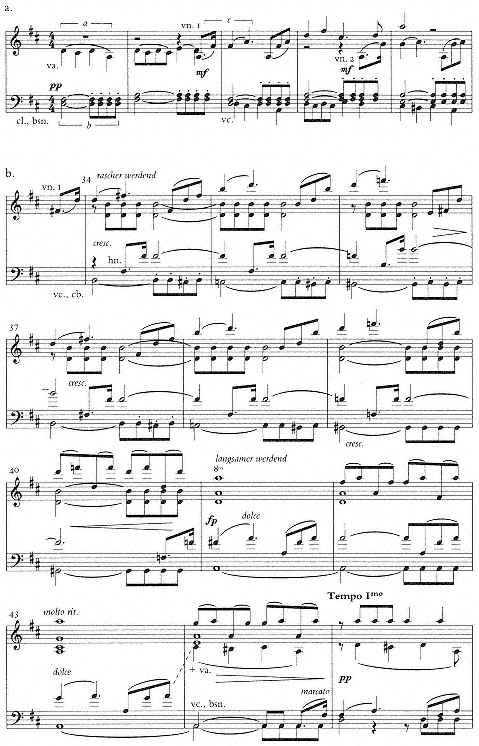
Example 2.3
Schoenberg, Serenade for Small Orchestra (1896), I.

Example 2.3
continued
B, and its chromatic lower neighbor,



The motivic-thematic process complements this harmonic one. For the ten measures preceding the retransition, Schoenberg has avoided developing motive c, which now reemerges at the arrival on B minor, accompanied by motive b in the cellos and basses. At the climax of the crescendo, in m. 40, the theme is dissolved or "liquidated" in diminution—much as Brahms treats his own analogous triadic theme at various points in the first movement of his Second Symphony (cf. mm. 59ff.). Throughout this passage, c has been presented by the strings (first violins and violas), while the horns reiterate only the dotted upbeat figure as a kind of ostinato on octave






The other portion of this movement that deserves commentary is the conclu-
[13] See, for example, the retransition and entrance of the recapitulation in the Andante of Brahms's Third Symphony, discussed in Frisch 1984, 137–40.
sion of the coda, where the tonic is reached not via the dominant, but directly from an augmented sixth chord (a German sixth, spelled






Although the harmonic vocabulary is relatively simple, the association between the two passages, retransition and coda, shows Schoenberg already thinking of harmonic function in terms of large-scale structure. The retransition and coda occupy analogous, or perhaps complementary, places within the sonata form: the retransition represents the moment of greatest harmonic tension, the coda the moment of least tension. To point up the relationship, Schoenberg employs dissonant harmonies that resolve by means of neighbor motion.
In the ways just analyzed, the first movement of the Serenade in D Major is a great step forward from the piano works of 1894. The work is a more effective, persuasive composition largely because Schoenberg has begun to internalize, to make his own, some of Brahms's more important techniques. In terms of the spectrum proposed in chapter 1, we might say that Schoenberg's emulation and allusion are now giving way to absorption. As we listen to the first movement of the serenade, we are less aware of the model than of the skill and naturalness with which Schoenberg manipulates the principles taken over from it.
The D-Major String Quartet and F-Major Scherzo (1897)
Many of the formal, thematic, and harmonic techniques that are beginning to bud in the Serenade in D Major come to fruition in the first large-scale instrumental work that Schoenberg was actually to complete (or allow to survive complete), the D-Major String Quartet. We can be certain that the quartet was revised extensively with Zemlinsky's advice. According to Egon Wellesz—and the information was confirmed by the composer—Schoenberg wrote the work in Vienna in the summer of 1897, then showed it to Zemlinsky upon the latter's return from a holiday. The first and last movements were considerably rewritten, and a new movement was composed in place of the original second one. Apparently at the time he showed Zemlinsky the quartet, Schoenberg had only just begun a third movement (it is not clear whether the fourth was complete); here too an-
other movement was substituted for the planned one.[14] At the instigation of Zemlinsky, the quartet was given a private performance at an evening of the Wiener Tonkünstlerverein on 17 March 1898. The public premiere was given by the Fitzner Quartet at the Bösendorfersaal of the Gesellschaft der Musikfreunde on 20 December of the same year.[15]
For the D-Major Quartet, there exist an autograph and a set of parts (at the Library of Congress), neither of which shows signs of the extensive revisions or substitutions mentioned by Wellesz and Schoenberg. The original second movement survives, however, as a Scherzo in F Major, for which the manuscript is dated 27 July 1897 at the beginning and 7 August 1897 at the end.[16]
Taken together, the D-Major Quartet and the F-Major Scherzo constitute the most successful instrumental works of Schoenberg's Brahmsian period, and as such they bear more extended analysis. The first movement of the quartet was Schoenberg's most expansive sonata form to date. The exposition, which is especially rich in thematic material, has the following shape:
Theme 1a, mm. 1–12
Theme 1b, mm. 13–16
Theme 1a', mm. 17–28
Transition, mm. 29–38
Theme 2a, mm. 39–46
[14] This information about the genesis of the quartet is gleaned from Wellesz 1925, 12–13, supplemented by information that Schoenberg provided Wellesz after the appearance of the latter's book in German in 1921. In the book Wellesz reports that the third movement remained unchanged, but Schoenberg wrote to him that "auch hier kam ein ganz anderer Satz an Stelle des geplanten." Schoenberg's remarks to Wellesz were passed on by Wellesz in 1965 to Oliver Neighbour, who reports them in the preface to Schoenberg 1966. (They also appear in SW B20: XII.) It should be noted that the English translation of Wellesz's biography, first published in 1925, already contained some corrections that Schoenberg had furnished to the author (and that the author had passed on to the translator), although not the information about the third movement of the D-Major Quartet. These other corrections are reported by Carl Dahlhaus in his afterword to a reprint of the German edition of the Wellesz biography (1985, 158–59). I am grateful to Neighbour for providing me with a photocopy of Wellesz's letter to him and for suggestions regarding the genesis of the D-Major Quartet.
[15] See Maegaard 1972, 1: 27–28; Hilmar 1974, 163. See also Zemlinsky 1934, 34.
[16] Published as Schoenberg 1984 and in SW A20. For further information on this scherzo, see also Maegaard 1983. Oliver Neighbour has suggested (personal communication) that a brief sketch contained near the bottom of the scherzo manuscript might have been intended originally as the theme for the third movement. This sketch is reproduced in SW B20: 222; another, much longer version of it is found at the bottom of a leaf containing a fragmentary Heyse setting, Vorfrühling, in the Nachod Collection in Texas (reproduced in Kimmey 1979, 222, item 97; mentioned in SW B1/2/I: 45). Although Neighbour's notion is potentially attractive, it seems unsupported by the theme itself, which is in meter and the key of major. It bears a resemblance to neither the eventual third movement nor the Intermezzo that replaced the Scherzo. This theme seems to demand a relatively rapid tempo (none is actually indicated by Schoenberg) and would thus be unsuitable for a slow movement, which is what we would expect to follow a scherzo.
Theme 2a', mm. 47–54
Theme 2b, mm. 55–64
Theme 2b', mm. 65–78
Theme 2c, mm. 79–86
Codetta, mm. 87–96
This exposition shares with the Serenade in D Major a preoccupation—not to say obsession—with motivic and thematic development. Unlike in the earlier work, however, Schoenberg does not set out three different motivic ideas more or less simultaneously. Instead, the opening theme is presented in unison and octaves by all four instruments, as if Schoenberg wishes to begin as transparently as possible. Example 2.4a shows the first two themes, 1a and 1b, of the tripartite first group. Already in its third measure, theme 1a begins to be "developed": mm. 3–4 form a free but recognizable retrograde of mm. 1–2.
The first twelve measures function as a period, in which mm. 1–4 are an antecedent and mm. 5–12 an expanded consequent that derives quite clearly from what has preceded it. The rhythm of four slurred eighth notes in m. 5 (labeled g ) is developed from the last two beats of m. 3. The rhythmic profile of m. 6 derives from the figure spread across the bar line between mm. 1–2 and 2–3 (x), where the dotted quarter note receives an accent. The consequent phrase explores the implications of that accent by shifting the figure so that it begins on the downbeats of mm. 6 and 8.
In the brief B section of the first group (mm. 13–16), g 'is further modified (hence g '): a rest appears in place of the first note. The pitch content retains the neighbor-note motion of the consequent form (as in mm. 5, 7, and 9), but now shifts it one eighth note to the right, so that in m. 13,

In the first group, Schoenberg saturates the texture within the rhythm and pitch content of g . In the consequent phrase, of the bass presents an inversion (


This developmental process continues past the first group, as is shown in ex. 2.4b, which is the climax of the transition and the beginning of theme 2a. Here motive g forms the beginning of a two-measure idea, of which the second measure is almost a rhythmic retrograde of the first. In the diminuendo and ritar-
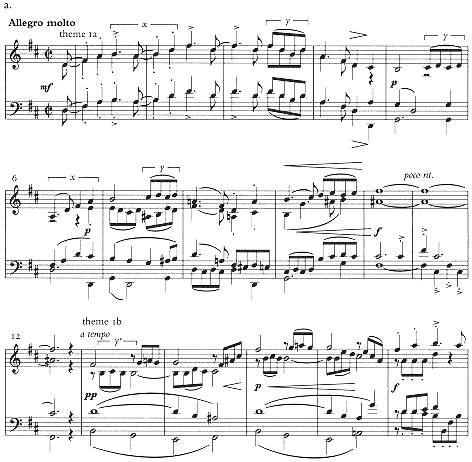
Example 2.4
Schoenberg, String Quartet in D Major (1897), I.
dando of mm. 37–38, the motive is liquidated to a single neighbor-note figure,


If the first group is especially impressive for its motivic concentration, the very broad second group of the first movement is striking for large-scale harmonic control. In this movement (unlike in the D-Major Serenade), Schoenberg avoids the dominant as a second key area, instead orienting the second group around B
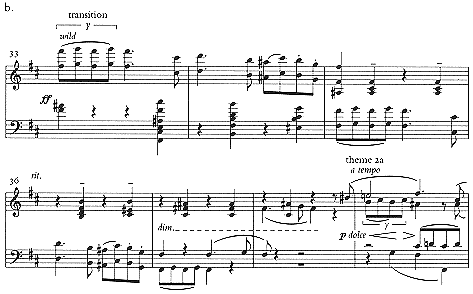
Example 2.4
continued
minor and major. The potential importance of the sixth or submediant degree is made apparent at the very opening of the movement: the pitch B is accented in m. 1; a B-minor triad is prominently outlined in mm. 2–3; and the consequent phrase begins in m. 5 with a sustained B in the first violin. At the end of Ia, Schoenberg begins to realize the harmonic implications of these initially melodic details: theme 1a ends with a half-cadence on

The second group of the exposition returns to, and remains in, the key of the submediant. What is most remarkable—and bears some scrutiny here—is how Schoenberg manages to sustain harmonic tension across the very broad, fifty-six-measure expanse of the second group. Theme 2a begins over a dominant pedal (








supports a German sixth chord in a distinctive third inversion. When this process is repeated sequentially up a minor third in m. 59, we are brought back to

All this chromatic activity and sequential motion makes 2b more of a transitional than a "thematic" section. Theme 2b' now serves to stabilize and, as it were, thematicize this material. Like 2a, however, this theme begins over a dominant pedal and touches down only fleetingly on the tonic B. At its climax this theme moves to V/V,



The various harmonic diversions and the constant return to an



As a whole, then, the first movement of the D-Major Quartet shows an impressive grasp of principles associated most closely, or most immediately, with the music of Brahms. By comparison, the possible influence of Dvorak[*] on this work seems insignificant. To be sure, as Reinhard Gerlach has noted, the outer movements of the quartet have a strongly Slavic flavor (Gerlach 1972, 124). He points especially to Dvorak's[*] F-Major Quartet, op. 96 (1894), which opens with a pentatonic-style theme not unlike Schoenberg's. But the resemblance is only superficial, for in the D-Major Quartet the emphasis on the sixth degree is not merely a local effect: as we have seen, Schoenberg goes on to build important structural features of the movement from the submediant degree. In its diatonic
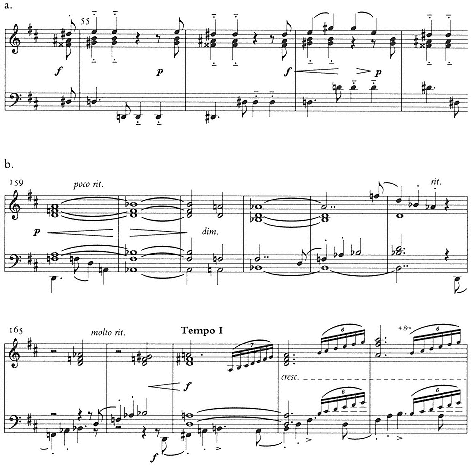
Example 2.5
Schoenberg, String Quartet in D Major (1897), I.
form as




Moreover, Schoenberg need not have looked to Dvorak[*] for a pentatonic melody; one still more similar to his own, and in the same key as his quartet, can be found in Brahms's op. 71, no. 1, the song Es liebt sich so lieblich im Lenze! (1877). Brahms's vocal melody (ex. 2.6) is in fact shaped very much like Schoenberg's
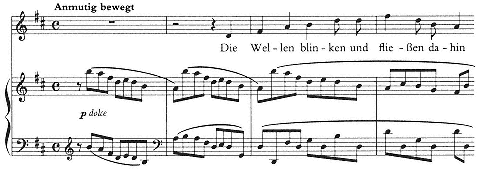
Example 2.6
Brahms, Es liebt sich so lieblich im Lenze! op. 71, no. 1.
theme, forming a broad triadic arch with the


What keeps the first movement of the D-Major Quarter rather earthbound, however, despite its motivic and harmonic elegance, is the four-square nature of its phrase structure and rhythmic-metrical language. Virtually every theme or section unfolds in four- or eight-measure units. The original second movement of the quartet, the F-Major Scherzo, shows greater flexibility in this regard, and (on a smaller scale) is equally accomplished in its motivic, formal, and harmonic aspects.
The main theme of the scherzo, presented by the viola (ex. 2.7), is one of the most economical and concentrated—and in these respects, prophetic—in all of early Schoenberg. The five-measure antecedent consists of malleable two-note motivic units (marked by brackets in the example) that take on various rhythmic and metrical shapes. In the first measure the unit begins on the downbeat with a quarter note. The initial note is then reduced to an eighth and placed in a weak metrical position as the upbeat to m. 2; this pattern is twice repeated within (and across) mm. 2–3. Schoenberg's manuscript fails to provide a slur from the upbeat in m. 3 to the downbeat of m. 4, but our ears can still trace the two further modifications of the two-note unit leading up to the cadence on F on the last beat of m. 4.
The treatment of the unit in mm. 2–3 implies (in the viola part only) a hemiola—a broad measure of


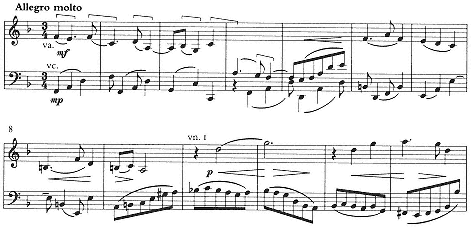
Example 2.7
Schoenberg, Scherzo in F Major for String Quartet (1897).
effect is distinctive here because the hemiola extends across the two interior measures of a four-measure phrase. Even in Brahms, the ostensible model for the device, a hemiola will usually begin on a strong bar (as in m. 25 of the third movement of the

In the consequent phrase (mm. 6–9), Schoenberg expands the basic motivic unit to three notes, which now remain comfortably within the bar line as the music takes on a more lyrical regularity. The cadence on iii, or A minor, leads to a new thematic idea in the first violin (m. 10). This new idea, an ascending fourth, is presented initially as a two-note unit, a free but conspicuous augmentation of the opening rhythmic shape. This motive is now answered by a phrase in which the two-note ascending fourth, in rhythmic diminution, becomes the first component of a figure that rises to A, then sinks back through G to the starting point, D.
Two aspects of this process are of particular interest. First, as in theme 1a of the first movement of the D-Major Quartet, Schoenberg shows a predilection for palindromic or retrogradable themes (D-G-A-G-D). Of greater significance is the way the five-note thematic figure of mm. 12–13 synthesizes the two rhythmic elements of the first theme: the two-note unit is now joined with, and completed by, a three-note one. That the A-G-D component is a three-note unit, despite the slur that covers all five notes in mm. 12–13, is confirmed by the independent appearance of the motive in mm. 20–21.
The motivic-rhythmic process traced here across the first part of the scherzo
equals in fluidity that of the first movements of the serenade and quartet. The same might be said of the elegant recapitulation within the scherzo proper (Appendix ex. C). The recapitulation enters over a dominant pedal, but it is the dominant of D, not F. The retransition has been governed by an intense E pedal, which pushes toward a resolution on A. When the A arrives in the bass in m. 88, after a dramatic one-beat Generalpause, it supports neither an A-major chord (the expected resolution) nor a first-inversion chord on the true tonic, F (which might have provided a clever way to introduce the tonic), but a D-major

In its turn, the A also proves deceptive. Instead of resolving to D, it moves up to





The entire recapitulation, then, shows a control of form, harmony, and voiceleading so impressive that we can only wonder why Zemlinsky advised Schoenberg to replace the scherzo. Perhaps the suggestion had more to do with Stimmung than with compositional technique: Zemlinsky may have felt that a relatively bumptious scherzo was no longer appropriate in chamber music at the fin de siecle. In his own works of this period, Zemlinsky tended either to substitute for the scherzo a more gentle allegretto in the manner of Brahms (the String Quartet, op.4) or to eliminate the scherzoaltogether (the Clarinet Trio, op.3, which has only one inner movement, a slow one). In the D-Major Quartet, Schoenberg decided on the former route: the second movement became a lilting Intermezzo in

The F-Major Scherzo and the Intermezzo that replaced it have in common the use of the viola as the principal melodic voice, a feature that seems to derive most directly from the third movement of Brahms's


Example 2.8
Brahms, String Quartet No.3. in

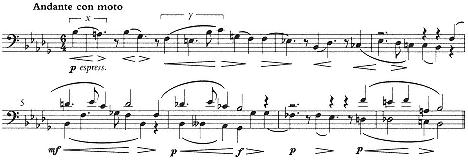
Example 2.9
Schoenberg, String Quartet in D Major (1897), III.
Brahms's first and second violins in mm. 7–8 as one of the principal accompanimental motives, which appears in the second violin, in mm. 1, 3, etc.) By comparison, the newer intermezzo seems tame. Schoenberg takes over the Klangfarbe of the Brahms (muted strings) with some elegance, but he loses the motivicrhythmic élan.
In suggesting that the scherzo be replaced, Zemlinsky may have felt that it was too close in general style and specific motivic content to Brahms's op. 67. If so, he failed to see (or hear) past the symptoms, to see how flexibly and creatively Schoenberg had reinterpreted Brahms's compositional techniques. To be sure, the new Intermezzo gave Schoenberg's quartet a more symmetrical, and unusual, tonal plan: across the four movements, the keys rise by major third,

the original third movement was retained when that movement was replaced by the present one.
In his brief reminiscences of Schoenberg, Zemlinsky remarks that although much of the D-Major Quartet was derivative from Brahms, "a middle movement already strikes an individual tone" (Zemlinsky 1934, 34). Recent commentators have assumed that by "middle," Zemlinsky meant the new second movement, the Intermezzo, whose composition he apparently encouraged (Gerlach 1972, 125; Thieme 1979, 113). But I suspect he intended the third, which in many respects is the most innovative and impressive of the five movements that survive.
The gnomic eight-measure theme (ex. 2.9) is, to my knowledge, unique in the variation literature in that the first half is played unaccompanied and the second half consists of two lines in counterpoint. (The texture and procedure are very different from baroque variations on a ground, and bear only a distant relationship to the finale of Beethoven's Eroica, where the "theme" is at first a single line, which is then joined by a counterpoint in the first variation.) There are two basic rhythmic motives, which are developed to some extent independently of intervallic concerns: the two-note figure of m.1 (x) and the more extended four-note figure of m.2 (y), which can also be heard as a combination of two two-note motives. Rhythm y, which serves to conclude both the antecedent and consequent of the first half of the theme, initiates the second half (mm. 5–6).
The two phrases of the first half are well balanced intervallically: the descending third of the antecedent (





Because of the sparse texture of the theme, the slightest chromatic detail seems to take on special significance. The emphasis on






One other aspect of the theme deserves particular mention: the emphasis on imitation in the antecedent of the second half, where the cello follows the viola in a rhythmic canon at the distance of a quarter note. The principle of imitation will prove important in the following variations, as will the particular relationship between the parts at this point in the theme.
The autograph score of this movement contains seven variations (five in minor, two in major) and a coda. Schoenberg indicated two of the variations for deletion, those between the present 3and 4 (in minor), and 4 and 5 (in major).[17] Throughout the variations, Schoenberg makes good, as it were, on the polyphonic-contrapuntal implications of the theme. The idea of canonic imitation proposed in the antecedent of the second half is taken up and developed in different ways—and at different moments—in each variation. In variation i, the two-note groups of the theme (the first violin) are imitated two beats later by the two-note groups in the cello. A similar but modified relationship exists in the varied repetition of the first part of variation 2 (mm. 21ff.), where the violin begins the two-note group on the upbeat, the cello on the downbeat. In the second half of the variation, all three upper instruments engage in imitation (mm. 25–26). In the first two measures of variation 3, the first violin and cello are in free rhythmic imitation; in the second half, Schoenberg intensifies the imitation at the place analogous to the preceding variation: all four instruments now participate. In variation 4, the violin and cello are again in rhythmic imitation, now at the close distance of a sixteenth note. In variation 5, the second violin and viola are in imitation.
Another significant feature of the variations is the way Schoenberg treats the rhythmic motive y at the beginning of the second half. From variation 1 on, the originally subordinate imitative voice begins to take on a motivic life of its own (let's call it z). In variation 1 (m. 13), y appears in the second violin; it is imitated, less strictly than before, in the viola and cello (z), where the first note is now shortened from a quarter to an eighth and the pitch contour is altered (ex.2. ioa). In the analogous spot in variation 2 (ex. 2.1ob), y is varied with continuous eighth notes, and treated imitatively by the second violin, first violin, and viola (mm. 25–26). Motive z has now completely shed its imitative role: in the viola and cello, it remains in the rhythmic form it assumed in the preceding variation (with the opening leaps inverted). Similarly, in variation 3 (ex. 2.1oc), a further diminution of motive y is treated imitatively independent of motive z, which appears in the first and second violins (m. 33).
Motive z is absent in variation 4 and in the two rejected variations, but receives its apotheosis, so to speak, in the final variation, variation 5 (ex. 2.1od). Here it changes position within the variation structure, appearing at the very opening (m. 63) instead of at the beginning of the second half. It thus stands in place of the expected two-note motive, x. Furthermore, z now generates its own imita-
[17] The two rejected variations appear in both Schoenberg 1966 and SW B20: 276–78. In the former, they are placed in the score in their original positions and are marked, respectively, A and B. In the latter, the rejected variations, printed only in the critical report, are called IV and VI. To avoid possible confusion with Roman numerals indicating harmonic function, I here adopt the A and B labels for the two variations, as well as the measure numbering of Schoenberg 1966.
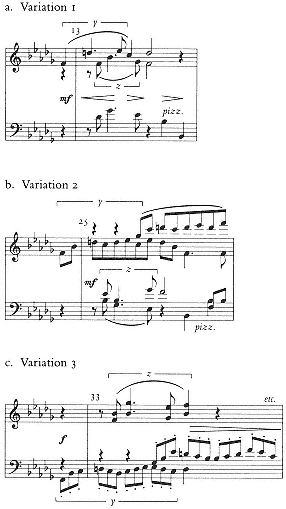
Example 2.10
Schoenberg, String Quartet in D Major (1897), III.
tion,between second violin and viola. At the opening of the second half of the theme—the customary position for z —Schoenberg retains only a small hint of the motive in the syncopated rhythm that begins in the viola (m. 70) and moves into the second violin (ex. 2.1oe).
The evolution undergone by z helps to give the entire variation structure a coherent shape. (Perhaps this is one reason Schoenberg deleted two of the variations, A and B, that bore no trace of z and thus did not contribute to the overall
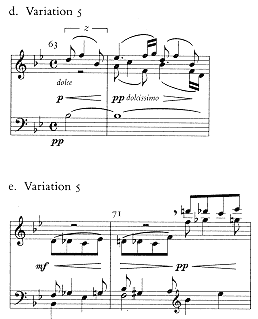
Example 2.10
continued
shape.) So too does Schoenberg's treatment of harmony. The initial harmonic structure of the theme is adhered to closely in variations 1 to 3. In each, as in the theme, the antecedent of the first half moves to V, the consequent back to i; the antecedent of the second half begins in the tonic major and moves to VI; the consequent returns to the tonic. This design is changed significantly for the first time in variation 4, where the second half begins directly in





The annexation, or integration, of these altered scale degrees is carried still further in the two major variations, B and 5. Instead of returning to I, the first half of variation B moves to III, or Dmajor, the key approached so forcibly in the preceding variation (4). The choice of key is significant in another respect: D, lying a major third above the tonic, serves as the symmetrical counterpart to the


The slow variation 5 is the first in which Schoenberg actually expands the original phrase structure: each half of the theme now lasts eight measures instead of four. In this way Schoenberg creates the temporal space, as it were, in which to synthesize important features of preceding variations. (We have already noted the "apotheosis" of motive z.) As in variation B, the second of the rejected variations, the harmony moves first to V, then to III, but now the pattern changes. In the second half, Schoenberg returns to the tonic relatively soon (mm. 72–73), but then, after a notated Luftpause, shifts abruptly to





With this elegant passage, Schoenberg has reintegrated into the major mode the


The final variation is a remarkable testimony to the young Schoenberg's powers of synthesis and long-range planning. And the variation movement as a whole stands as his finest achievement within the Brahms chamber music tradition. The D-Major Quartet is, in fact, Schoenberg's last work that falls directly within that tradition. Between the composition of the quartet in the summer and fall of 1897 and the composition of the sextet Verklärte Nacht almost exactly two years later, he was not to complete another piece of instrumental music. Any link between the two works seems to have been forged not in the realm of instrumental music, but in that of Lieder.
Chapter Three—
The Songs
By far the largest proportion of Schoenberg's early works consists of Lieder. There survive autographs for thirty-two complete songs (and more fragments) that were written before the end of 1900 but did not appear among Schoenberg's first published collections, opp. 1,2, and 3 in 1903–4.[1] Since fewer than a third of the manuscripts were actually dated by Schoenberg (only after 1897 did he begin to provide dates with some consistency), the problem of establishing a firm chronology is even harder than in the instrumental works. First attempts along these lines were made by Walter Bailey (1979) and Ulrich Thieme (1979, 127–43), who (independently of each other) separated the early songs, principally on the basis of style, into three main periods: a largely autodidactic phase up to about 1894; a distinctly Brahmsian phase up to about 1897; and a more chromatic, Wagnerian phase from 1897 to 1899. The development thus charted is plausible and agrees essentially with that outlined by Schoenberg himself in his writings.
A more precise chronology, based principally on paper types and handwriting in the song manuscripts, has been proposed more recently (1989) by Christian M. Schmidt in the critical report for SW B1/2/I:42–52. The results are persuasive and are basically consistent with the stylistic development suggested by Bailey and Thieme, as well as with the picture of the early Schoenberg that has been drawn thus far in part I of the present study. In the absence of precise datings from Schoenberg himself or from other biographical sources, Schmidt's work should be accepted as the most accurate available; it forms the basis of the list of early songs through 1897 given in table 2.
[1] The early songs, which are scattered among several collections and institutions, were first inventoried by Stein 1977 and Bailey 1979, whose work has now been superseded by, and incorporated into, the comprehensive critical report prepared by Christian M. Schmidt for SW B½. Seven of the early songs were published as Schoenberg 1987. All have now appeared in SW A1 and A2.
| |||||||||||||||||||||||||||
Based on a fresh assessment of these works, and in light of the more precise chronology now available, I would refine and reshape somewhat the version of Schoenberg's development given by Bailey and Thieme. We can discern a fourstage development, which forms the basis for the analytical commentary in this chapter and can be summarized as follows:
1. Most of the songs that appear to antedate 1894 are rather pallid imitations of Brahms and Schumann, with one exception, Schilflied ("Drüben geht die Sonne scheiden") of 1893, which shows a highly original, if still tentative, compositional voice.
2. With Ecloge of 1895, which went through three different versions (more than any other surviving early song), Schoenberg breaks free of the the more obvious Brahmsian imitation and refines certain harmonic-formal techniques explored in Schilflied.
3. With the two Heyse settings Mädchenlied and Waldesnacht, which were almost certainly composed in 1897, Schoenberg seems to return more self-consciously to Brahms, but now achieves a genuine internalization or absorption fully on a level with that of the contemporaneous D-Major Quartet.
4. Schoenberg moves definitively away from the Brahms idiom—but not from its fundamental compositional principles—in the two Dehmel settings from the fall of 1897, Mädchenfrühling and Nicht doch! Here he reaches toward the newer, more individual kind of musical expression that was to culminate in his works of 1899.
One aspect of Schoenberg's activity as a song composer that appears quite early on (although it is by no means unique to him) is a tendency toward concentrated involvement with specific poets for short periods. Moreover, the quality of the poetry seems directly related to the musical results. Thus, in the earliest period, up to about 1895, there are eleven relatively uninspired complete (and other fragmentary) settings of poems by Ludwig Pfau, a minor figure from the sentimental, volkstümlich romantic tradition. With the two Heyse settings and then the Dehmel settings of 1897, the higher quality of the poetry seems to stimulate a higher level of musical composition.
Schilflied
Schilflied, which Schoenberg's childhood friend David Josef Bach has testified was composed in 1893 (Bach 1924, 317), brought Schoenberg his first semi-
official recognition: it was awarded a composition prize by the amateur Viennese orchestra Polyhymnia, the group Schoenberg was to join as cellist in 1895.[2] In another song datable to 1893, In hellen Träumen, Schoenberg worked with a rather mawkish text by his schoolmate Alfred Gold. In Schilflied, he turned to a more venerable poem, one of a set of five Schilflieder published in 1832 by the romantic author Nikolaus Lenau. (Although Schilflied thus refers as a title to the set of poems, and not the individual text, which begins "Drüben geht die Sonne scheiden," I shall for ease of reference continue to call Schoenberg's song Schilflied in the present chapter.) This group of poems became extremely popular with composers of the nineteenth century. A scan of Ernst Challier's Grosser Lieder Katalog reveals that by the time Schoenberg wrote his song, in 1893, at least fifty-seven settings of this particular text, "Drüben geht die Sonne scheiden," had appeared in print (Challier 1885). Conceivably the choice of text was dictated by the Polyhymnia prize competition.
The poem (printed here as it appears in Schoenberg's manuscript) is in many respects a characteristic creation of German romanticism, in which nature becomes a metaphor for, or projection of, the feelings of a solitary protagonist:
Drüben geht die Sonne scheiden,
Und der müde Tag entschlief.
Niederhangen hier die Weiden
In den Teich, so still, so tief.
Und ich muß mein Liebstes meiden:
Quill, o Träne, quill hervor!
Traurig säuseln hier die Weiden,
Und im Winde bebt das Rohr.
In mein stilles, tiefes Leiden
Strahlst du, Ferne! hell und mild
Wie durch Binsen hier und Weiden,
Strahlt des Abendsternes Bild.
[2] As has been realized by Schmidt, the entry for Schilflied in Maegaard 1972, 1: 156, is in error in stating that the manuscript is part of group of Lieder (at the Morgan Library) enclosed in a wrapper headed "4 Lieder korrigiert 16." This information led Bailey (1979, 53–54) to suggest that the surviving manuscript of Schilflied may represent a later revision. The wrapper actually belongs to drafts of four songs from the Hanging Gardens cycle, op. 15, also at the Morgan (nos. 3, 4, 5, and 8; see Maegaard, 1: 62, and SW B1/2/I: 24 and 50–51). (Schmidt seems to accept that the wrapper reads "korrigiert" and thereby acknowledges a potential problem with the Hanging Gardens songs, for which a 1916 revision is unlikely. To my eye, the scribble is by no means definitively readable as "korrigiert.") In short, there is no physical evidence to contradict Bach's suggestion that Schilflied is a song of 1893.
Over there the sun goes down, and the weary day closed its eyes. Here the
willows droop in the still, deep pond.
And I must stay away from my beloved: flow, my tears, flow forth! Here
the willows are rustling in sadness, and the reed trembles in the wind.
Into my still, deep suffering you shine, O distant one! Bright and gentle, as
through rushes here and willows, shines the image of the evening star.
Schoenberg shapes Lenau's three stanzas into a rounded four-part song, in which the central stanza is divided musically into two parts: the overall form is thus A (m. 1), B (m. 19), C (m. 27), A' (m. 35). The song represents perhaps the earliest surviving example in Schoenberg's works of the kind of motivic-rhythmic concentration that was to become a hallmark of his compositional technique and that we have noted in the D-Major Quartet and F-Major Scherzo.
The prelude (Appendix ex. D) is dominated by an almost obsessive repetition of a two-note, short-long figure, which is traded between the two hands. When the voice enters in m. 5, the motive continues in the accompaniment, but its articulation is now modified. The left hand plays as before, but in the right, slurs now join the longer note to the succeeding shorter note. The motivic forms in the voice at the end of the stanza, in mm. 11–13, are clearly heard as further modifications of the original two-note figure.
The economy of the motivic language may well have been inspired by Schoenberg's early encounters with Brahms's music, but there is in fact little else of a recognizable Brahms style in Schilflied. In the harmonic language, especially, Schoenberg seems engaged in an empirical or intuitive exploration of the kind of chromatic chords he was later to label "vagrant." Extensive use of vagrant harmonies is, of course, a major aspect of the style of Liszt, Wagner, and Wolf, a repertory that Schoenberg claimed to have discovered only in 1898–99 (as reflected in works discussed in succeeding chapters). Schilflied in no way invalidates that claim, for in it the augmented, diminished, and half-diminished chords are employed in a manner very different from that of Wagner or Wolf. These harmonies do not arise primarily from the kind of stepwise chromatic voice-leading that might be called Tristanesque. Instead, they occur to extend, delay, or obscure basic diatonic progressions. Hence my characterization of Schoenberg's harmonic language here as "empirical" and intuitive; it is as if he is discovering the properties of vagrant chords on his own.
The prelude essentially sustains or prolongs a dominant, E-major harmony. However, as I have indicated with the brackets underneath mm. 1–4 in Appendix ex. D, the bass line actually arpeggiates not the dominant triad, but a more ambiguous half-diminished seventh chord,


Example 3.1
Tonal structure of Schilflied.
inant triad, but with an augmented chord spelled

In this first section of the song, then, Schoenberg uses the vagrant harmonies to deemphasize the tonic-dominant axis and thereby capture something of the general Müdigkeit or lassitude conveyed by the poem. In the impassioned B and C sections, the vagrant harmonies surge more forcefully and continuously. The initial key area of the B section, D minor, is immediately overridden by a succession of seventh chords: minor, half-diminished, and diminished. Particularly striking here is the tritone motion in the bass of mm. 22–24, supporting the juxtaposition of a C-minor seventh chord and a second-inversion augmented triad with a


If we step above, or behind, the many harmonic regions touched on in Schilflied, what emerges is a coherent, if idiosyncratic, large-scale structure, which is sketched in ex. 3.1. The song proceeds essentially by fifth through the arrival on G minor in m. 25. The status of G minor as the long-range goal of this "progression" helps to explain why it is given such emphasis in mm. 25–26—more emphasis, indeed, than is given to the tonic in the A section. At the end of the C section, this G can be heard to descend stepwise to F, or the sixth degree in A minor, which in turn drops to E to begin the A' section.
Because of the tension sustained in this way across large spans, the song can even be heard as having some of the tonal dynamic characteristic of a sonata form: the A section functions as a kind of exposition, centered around tonic and dominant; the B section is a far-ranging "development," reaching a remote G minor; C is a "retransition," moving to a sonority that becomes recognizable as the sixth degree, upper neighbor to the dominant; A' functions as a "recapitulation." I use these terms not to imply that Schoenberg was attempting a song in
sonata form, but to suggest that the song manifests ambitious "instrumental" impulses that might be said to strain against the traditions of the song medium.
Ecloge
Some of these same impulses can be detected in another remarkable song, Ecloge, which, although not dated by the composer, was probably composed in 1895. The poet, not named on any of the three manuscripts for the song, has recently been identified (SW A2: 67) as the Czech Jaroslav Vrchlický (a pseudonym for Emil Frida). Schoenberg appears to have taken this text from a German translation of some of Vrchlický's lyrics that appeared in 1895.[3] The poem is not an eclogue in the strictly classical sense of a pastoral dialogue, but is rather an attractive romantic lyric associating spring, described in stanzas 1 and 2, with love, described in parallel terms in stanzas 3 and 4:
Duftreich ist die Erde und die Luft krystallen,
Und das Moos erzittert unter deinem Fuß,
Aus dem Schilfrohr hör'ich's wie von Pfeifen schallen,
Und vom Hagedorn fälk heller Blütengruß.
Und das Aug' von Freude naß,
Fragst du: Ja, was soll all das?
"Was?"
Ruft der Vogel und die Blume spricht:
"Anders kommen doch des Lenzes holde Wunder nicht!"
Hell dein Blick, dein Atem süß vom Duft der Erlen,
Und es bebt dein Busen, wie ich dich umfang';
Wie aus hartem Felsen springen Quellenperlen,
Bricht aus meinem Herzen glühender Lieder Drang.
Und das Aug von Freude naß,
Fragst du: Ja, was soll all das?
"Was?"
Ruft der Vogel und die Blume spricht:
"Anders kommen doch der Liebe holde Wunder nicht!"
[3] See Gedichte von Jaroslav Vrchlický, translated by Friedrich Adler (Leipzig: Reclam, n.d.). Since Adler's preface is dated December 1894, we can assume the volume appeared in 1895. This book was only one of several collections of Vrchlický's poems published in German, beginning in 1886. The poem "Duftreich ist die Erde," no. 5 in a volume of ten eclogues originally published in Czech in 1880, appeared in several of the German collections; but only the Adler translation of 1895 matches the one used by Schoenberg (with minor differences of spelling and punctuation). Thus we can safely assume (with Schmidt, SW B1/2/I:11) that this volume served as Schoenberg's source. The date of 1895 also fits in plausibly with the stylistic-compositional development traced in this chapter. The text of the poem as printed here is taken from the Adler volume. In the Adler volume the generic title "Ekloge" is given with a k, whereas in the only one of Schoenberg's manuscripts to bear the title at all (at the Schoenberg Institute), it appears with a c. In SW, Schmidt follows Adler's spelling; here I have followed Schoenberg's, hence Ecloge.
The earth is rich with scents, the air crystalline, and the moss trembles
under your foot. From the reed I hear a sound like that of pipes, and from
the hawthorn descends the bright greeting of blossoms. What does all this
mean? you ask, your eyes wet with joy. "What?" calls the bird, and the
flower responds: "The sweet miracle of spring comes in no other way."
Your gaze is bright, your breath sweet with the scent of alder, and your
breast throbs as I embrace you. As pearls of water spring forth from hard
stones, thus does a rush of radiant songs burst from my heart. What does all
this mean? you ask, your eyes wet with joy. "What?" calls the bird, and the
flower responds: "The sweet miracle of love comes in no other way."
Following the poem, Schoenberg's setting is strophic on the largest scale: it is based on an almost exact repetition of a musical unit of 49 measures. The way in which the musical strophe is shaped—and, among the three manuscripts, reshaped—bears certain resemblances to Schilflied. The overall form of the strophe can be considered A (mm. 1–15), A' (16–23), B (24–30), A" (31–49) (see Appendix ex. E).
As in Schilflied, Schoenberg attempts in this song continually to sidestep the tonic,




The broad, dissonant leaps make the vocal part of Ecloge considerably more advanced than that of Schilflied. The piano part also has a more independent, continuous motivic process, which unfolds in the tenor range, underneath the cascading eighth notes. As in the other song, the basic motive is a very concise one, here the four-note

The virtually equal status of piano and voice in Ecloge is confirmed by the exchange at the start of the A" section. In mm. 31–34, the voice takes over the the-matic skeleton of the right-hand eighth-note figuration of mm. 1–4, and the right hand of the piano plays the disjunct theme formerly sung by the voice. The exchange ends in m. 35 as Schoenberg introduces new vocal material and a new kind of texture for the line beginning with "Anders kommen." It is here that we find
the first real signs of technical unsureness in the song. The passage seems clumsy, unmotivated, perhaps because we have not had enough of a real "return" to justify a new departure, which is then followed by a sudden push toward the apparent climax of the song on the big


My own dissatisfaction with the passage beginning at m. 35 was apparently shared by Schoenberg, who altered it in each of the three autographs for Ecloge. Although none of the three manuscripts bears a date, their order of completion can be surmised on the basis of the passage in question. The earliest version is a fragment (in the Nachod collection at North Texas State University; reproduced in Kimmey 1979, 204–6), which breaks off after the first musical strophe (and in which Schoenberg has inadvertently substituted "der Liebe," from stanza 2, for "des Lenzes" from stanza 1). The version of the song at the Pierpont Morgan Library (as reproduced in Appendix ex. E), close in handwriting style to the Texas copy, is almost certainly the second in order: it is a complete draft of the song, but shows signs of intended revision in mm. 24–25 and 35–37, which have wavy lines drawn across them. The copy at the Schoenberg Institute is the third manuscript. A fair copy with breathing marks written in, it was apparently intended for performance.[4]
Originally, the Schoenberg Institute copy (the third) corresponded almost exactly to the Morgan one (the second), but Schoenberg began to revise extensively at precisely one of the spots marked with a wavy line in the Morgan copy, at "Anders kommen" in mm. 35ff. Although the crossots and pasteovers in the Institute copy do not in fact yield a complete, coherent draft of the song, we can reconstruct at least the state in which he left the "Anders kommen" passage before apparently abandoning work on the song. The three versions of this passage are superimposed in ex. 3.2.
In Schoenberg's first attempt, ex. 3.2a, the parallel-fauxbourdon texture at "Anders" involves even the bass, which is high in its register and plays in eighth notes. The vocal line and the top part of the piano here are initially a fourth higher than in the version of 3.2b. In 3.2b, Schoenberg brings the first "Wunder nicht" (mm. 7–8) down a minor third, to


The most far-reaching changes, however, come in the third version, 3.2c. Two aspects are particularly striking: the different figuration at "Anders" and the new
[4] That this third draft of Ecloge forms part of a gathering with Waldesnacht, which was almost certainly composed in 1897, has led Schmidt to suggest that Schoenberg may have attempted this revision in 1897, thus two years after the first draft (SW B1/2/I: 45).
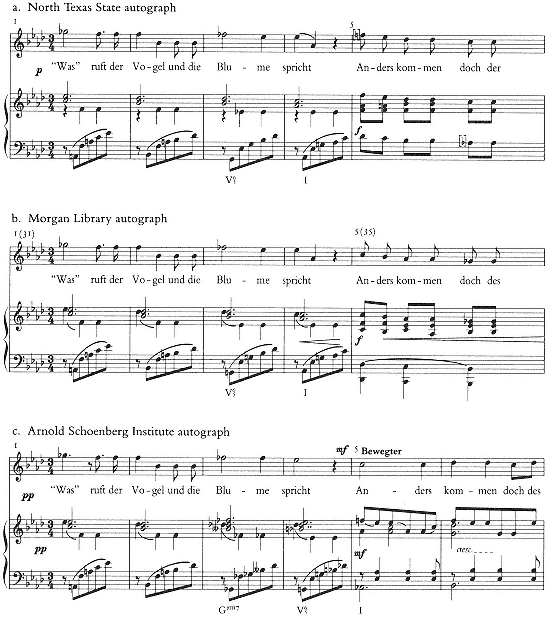
Example 3.2
Comparison of versions of Ecloge.

Example 3.2
continued
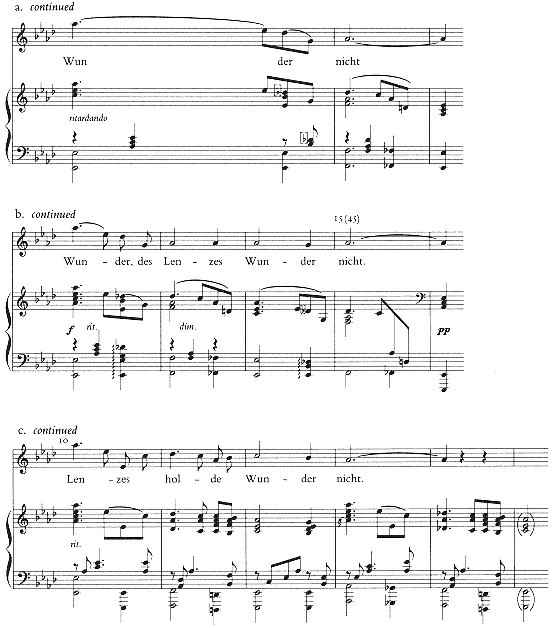
harmonization from "Blume" onward. As to the first: Schoenberg must have realized that the parallel chordal style is too anomalous, especially in a recapitulatory section. He thus abandons it and reintroduces the basic slurred eighth-note figuration of the A section. At the same time he reshapes the harmonic progression so as to avoid arriving on the tonic at "spricht" in m. 4. He understood that this tonic made for too much closure in versions a and b and that it tends to undercut the arrival on the tonic


Schoenberg thus reharmonizes the





In 3.2c, Schoenberg has shifted the weight and placement of the climax. In the earlier versions the




I have dwelled on the successive revisions of this small passage from Ecloge because they have a significance broader than their immediate context. They show Schoenberg grappling with fundamental compositional issues of thematic, formal, and harmonic balance. More than in Schilflied, he seems to be questioning the proper shape and status of a "recapitulation" or return: how to prepare it harmonically, how long it needs to be to accomplish its formal purpose, how it should transform earlier material, and so forth.
In these ways, both Schilflied and Ecloge open up a number of promising paths that Schoenberg might have been expected to follow immediately in 1895. In fact, it is not clear just what direction his song composition took over the next one or two years. This was the period of his private study with Zemlinsky, who may have encouraged Schoenberg to return to and master the Brahmsian model, to "get it right," so to speak (something that, as I suggested in chapter 1, Zemlinsky himself failed to do in Heilige Nacht). In any case, this period culminates in Schoenberg's most profoundly Brahmsian songs, Mädchenlied and Waldesnacht (1897). Here we find the kind of assimilation and absorption missing from earlier efforts, especially apparent in the phrase structure, motivic development, and
harmonic expansion. Each of the two songs seems to draw consciously on a different Stimmung typical of Brahms—the first light and folk-like, the second slow and broadly lyrical. In both, Schoenberg turns to Paul Heyse, whose poems Brahms himself had set on several occasions, and who is a substantial cut above Ludwig Pfau.
Mädchenlied
Schoenberg sets the poem "Mädchenlied" as a modified strophic song in which two poetic stanzas are grouped into one musical strophe:
Sang ein Bettlerpärlein
Am Schenkentor,
Zwei geliebte Lippen
An meinem Ohr:
Schenkin, süße Schenkin,
Kredenz dem Paar,
Ihrem Dürsten biete
Die Labung dar!
Und ich bot sie willig,
Doch der böse Mann,
Biß mir wund die Lippen,
Und lachte dann:
Ritzt der Gast dem Becher
Ein Zeichen ein,
Heißt's er ist zu eigen
Nur ihm allein.
A pair of beggars sang at the tavern door; two seductive lips at my ear said:
Barmaid, sweet barmaid, serve this pair. For their thirst offer refreshment.
And I offered it gladly, yet the wicked man bit and hurt my lips and
laughed:
If a guest carves his sign on a cup, they say it belongs to him alone.
The song (first strophe in Appendix ex. F) is a direct counterpart to the first movement of the D-Major Quartet from the same year, not only in key and mood but also in the triadic/pentatonic build of the opening melody, which likewise emphasizes the sixth degree, B, and a B-minor harmony. Brahms, of course, is the ultimate model. Indeed, Schoenberg seems to have had a specific Brahms song in his ear: Ständchen, op. 106, no. 1, whose first phrase concludes with the same

It is in the more subtle relationships between voice and piano and in the fluid phrase structure that Schoenberg's song reveals a more genuine Brahmsian inheritance. In the first two phrases, mm. 1–5, the accompaniment repeats a brief three-note motive, x, the neighbor-note figure heard first as

This motivic transference forms part of a still more sophisticated exchange of material between voice and piano. As the voice reaches the half-cadence on the dominant in m. 5, the piano begins a restatement of what was originally the vocal theme, now in the dominant. From the second half of m. 6 this restatement begins to deviate slightly from the original (an exact transposition would bring an E in the right hand on beat 3 of m. 6), but the contour and rhythms are fully recognizable through m. 7.
This piano statement actually overlaps with the conclusion of the first vocal phrase in m. 5 and the beginning of the next one in m. 6. There is thus an asynchronous relationship between voice and accompaniment here, perhaps intended by Schoenberg as a kind of musical corollary of the drunken beggars outside the tavern. The voice and accompaniment could be said to get back into phase in m. 8, for the final phrase of the strophe.
The flexible relationship between piano and voice in Mädchenlied makes the analogous techniques in Ecloge —the piano's motivic development and the interchange of material at the recapitulation—look rudimentary. More significantly, the comparison suggests that it was in emulating Brahms's music that Schoenberg found the ways to expand on techniques already present in his own earlier songs.
Waldesnacht
If Mädchenlied pays homage to Brahms's sophisticated Volkston, Schoenberg's Waldesnacht draws impressively on the rich fund of broad, slow songs like Feldeinsamkeit. Where Heyse's "Mädchenlied" poem is concise and epigrammatic, his "Waldesnacht" is expansive, almost hymnic:
Waldesnacht, du wunderkühle,
Die ich tausend Male grüß,
Nach dem lauten Weltgewühle
O wie ist dein Rauschen süß!
Träumerisch die müden Glieder
Berg' ich weich ins Moos,
Und mir ist, als würd' ich wieder
All der irren Qualen los.
Fernes Flötenlied, vertöne,
Das ein weites Sehnen rührt
Die Gedanken in die schöne,
Ach, mißgönnte Ferne führt!
Laß die Waldesnacht mich wiegen,
Stillen jede Pein,
Und ein seliges Genügen
Saug' ich mit den Düften ein.
In den heimlich engen Kreisen
Wird dir wohl, du wildes Herz,
Und ein Friede schwebt mit leisen
Flügelschlägen niederwärts.
Singet, holde Vögellieder,
Mich in Schlummer sacht!
Irre Qualen, löst euch wieder;
Wildes Herz, nun gute Nacht!
Forest night, wondrous cool, I greet you a thousandfold; after the noisy
turmoil of the world, oh, how sweet is your rustling! Dreamily I bury my
weary limbs in the soft moss, and it is as if I were freed from all my
confused torments.
Sound, distant flute song, which stirs a vast longing and leads my
thoughts to the lovely distance, oh so begrudged! Let the forest night
lull me and silence my pain, and I breathe a blissful contentedness with its
fragrance.
In your secretive, close confines you will recover, restless heart. And peace
floats downward on gently beating wings. Sing me to gentle slumber,
tender bird songs! Begone, delirious torments; good night, then, restless
heart!
Schoenberg's setting of the poem is modified strophic; the changes come principally in the vocal part of lines 5–6 of each stanza, analogous to mm. 14–17. (Appendix ex. G gives only the first musical strophe in full.) For this song, Schoenberg had a direct model in Brahms's own setting of the Heyse's "Waldesnacht" as a song for mixed chorus, op. 62 (ex. 3.3). A comparison of the opening phrase in the two settings will show how Schoenberg responds to Brahms's predilection for asymmetry. The first two lines of the poem, which have eight regular metrical stresses, would fall naturally into a phrase of four full measures, divided 2+2. Where in one of his earlier songs Schoenberg would almost certainly have followed the four-square approach, here he emulates Brahms in extending the first phrase to five measures, or eighteen quarter beats. But he follows the spirit rather than the letter of Brahms's practice: Brahms augments the note values on "kühle" and "die"; Schoenberg creates a beautiful ascending melisma
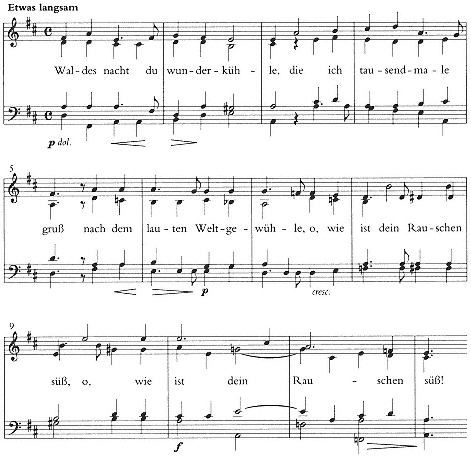
Example 3.3
Brahms, Waldesnacht , op. 62, no. 3.
on the first syllable of "wunder." By means of word repetition, Brahms extends his second phrase still further, to six full measures, or twenty-four quarter beats. Schoenberg moves in the opposite direction, compressing lines 3–4 into four measures plus an upbeat, or seventeen quarter beats.
Schoenberg's integration of chromatic detail within a diatonic context places this song well beyond his other Brahmsian efforts and can, indeed, stand beside Brahms's own practice in chromatic passages like mm. 6–10 of the choral song Waldesnacht. We might note especially Schoenberg's elegant treatment of the flatted sixth degree,


Example 3.4
Schoenberg, Waldesnacht , strophe 3, mm. 58–61 (vocal part only).
monically respelled as


The





Two other aspects of the song merit comment here. The first is the subtle evolution of the piano texture across the strophe. The staggered arpeggiation of mm. 3–12 gives way in m. 13 to full chords alternating between the hands. After the fermata of m. 17, this texture evolves into the parallel chordal style in which the piano doubles the voice. We have encountered this texture before, in the "Anders kommen" section of Ecloge. There it seemed merely awkward, and Schoenberg eventually abandoned it (see ex. 3.2c above). In Waldesnacht, however, the parallel chordal style has been carefully prepared and makes for a wonderfully effective climax to the musical strophe.
The second aspect of the song that is noteworthy is the transformation of the vocal part in the third strophe, at mm. 58–61 (ex. 3.4; cf. mm. 14–17 of Appendix ex. G). Here the voice in essence takes over the top line of the piano part (with the addition of a downward sixth leap at "Vogel"). The enharmonic and chromatic steps carry this phrase well beyond the Brahmsian idiom of the rest of the song. Indeed, this kind of line—as well as its harmonic underpinning, including a whole-tone chord on the last beat ofm. 14/58—would be at home in a Schoenberg work of 1899, or perhaps in Gurrelieder.[5]
[5] This vocal line actually represents a revision written by Schoenberg over the original line, which was as in strophe i. In SW A2: 85, Schmidt opts for the original version and banishes the chromatic revision to the critical report (SW B1/2/I: 294). This seems to me an unfortunate editorial decision. Schoenberg 1987 gives mm. 58–61, as in my ex. 3.4.
This passage shows quite vividly that Waldesnacht marks the farthest Schoenberg could go within the Brahms "style". Together with the variation movement of the D-Major String Quartet (examined in the previous chapter), the song can be said to represent the culmination of his period of Brahms study; it is his graduation piece, so to speak, or the work pointing the way out of the "Brahms fog". That path was to be opened still more forcefully in the fall of 1897 with Schoenberg's turn away from the kind of poetry represented by Heyse to the newer kind of verse embodied in the works of Richard Dehmel.
The Dehmel Settings of 1897
In one of the early manifestos of German modernism, a polemical essay of 1885 called "Die neye Lyrik", the literary critic Karl Bleibtreu called for a reaction against the folk-like tradition in German poetry as represented by Heyse. He bemoaned the fact that "the Volkslied, coming by a detour through Goethe, is taken by most critical papists as the only valid norm of the so-called 'genuine [echte] lyric.'" He added, with obvious sarcasm, "Ah, the 'genuine lyric' is indeed so easy: a little mood, a little rhyme, and the masterwork is ready." Bleibtreu demanded a new kind of poetry that would exhibit not only greater naturalism (the first catchword among the early modernists) but also greater subjectivity: "In the first place, subjectivity must be released, in order to break the stiffness of the conventional patterns" (in Ruprecht 1962, 51–53).
The new subjectivity or individualism in poetry, strongly influenced by Nietzsche in the late 1880s and 1890s, was to take many forms in expression and technique. But it was nowhere embodied more strikingly than in the verse of Richard Dehmel (1863–1925), whose first collection of poetry appeared in 1891.[6] By the late 1890s, Dehmel was perhaps the most famous poet in Germany (or with Stefan George, one of the two most famous). The public and press were at once attracted and scandalized by Dehmel's eclectic blend of what the critic Julius Hart in 1896 characterized as "archaism, symbolism and allegory, everyday-realistic naturalism, with elements of sexuality, immorality and Satanism, and the Nietzschean superman" (in Ruprecht and Bänsch 1970, 15).
This poetry apparently held no attraction for the older generation of composers; Brahms dismissed it as "not well suited for musical treatment" (in Birke 1958, 280). But the younger musicians, including Richard Strauss, Zemlinsky,
[6] The principal collections of Dehmel's poems published in the 189os include Erlösungen: Eine Seelenwandlung in Gedichten und Sprüchen (Stuttgart: Göschen, 1891); Aber die Liebe: Ein Ehemanns-und Menschenbuch (Munich: Albert, 1893); Lebensblätter: Gedichte und Anderes (Berlin: Verlag der Genossenschaft PAN, 1895); Weib und Welt: Gedichte (Berlin: Schuster & Loeffler, 1896); and Erlösungen: Gedichte und Sprüche, 2d ed., rev. (Berlin: Schuster & Loeffler, 1898).
Reger, Schoenberg, and (slightly later) Anton Webern, were strongly drawn to it.[7] Dehmel was the first major contemporary poet to whom Schoenberg devoted sustained creative attention. And it was a conversion that was to have farreaching implications for his musical style.
In a well-known letter to Dehmel of 1912, Schoenberg himself acknowledged the poet's profound impact, noting that
your poems have had a decisive influence on my development as a composer. They were what first made me try to find a new tone in the lyrical mood. Or rather, I found it even without looking, simply by reflecting in music what your poems stirred up in me. People who know my music can bear witness to the fact that my first attempts to compose settings for your poems contain more of what has subsequently developed in my work than there is in many a much later composition.
SCHOENBERG 1964, 35
In another letter, written a year later, Schoenberg reiterated Dehmel's influence on the younger generation: "Far more than any musical model, it was you who determined the platform of our musical experiments" (Birke 1958, 285).[8] These are strong sentiments, but they constitute no great exaggeration when we consider the enormous role played by Dehmel in Schoenberg's early works: between 1897 and 1906 he was to sketch or complete at least eighteen works based on Dehmel's poetry. Among these are some of his most important early compositions.
The two earliest Dehmel songs, completed in September 1897, were Mädchen-frühling and Nicht doch! After a hiatus, Schoenberg returned to Dehmel in the spring of 1899 (as we shall see in the next two chapters). A single Dehmel collection, Weib und Welt (1896), was to provide the source for all of Schoenberg's Dehmel works of 1899. For the two settings of 1897, Schoenberg turned to an earlier volume, Aber die Liebe (1893). It seems significant that Schoenberg selected Dehmel poems that, although tinged with erotic subjectivity, nevertheless show their allegiance to the folk-like tradition represented by the Heyse texts for Mädchenlied and Waldesnacht. There is, however, enough difference in the poetry to
[7] See Sichardt 1990. After Schoenberg, Strauss composed the most Dehmel works. His ten songs, composed between 1895 and 1902, comprise Stiller Gang, op. 31, no. 4; Mein Auge, op. 37, no. 4; Leises Lied, Der Arbeitsmann, Befreit, and Lied an meinen Sohn, op. 39, nos. 1, 3, 4, and 5; Wiegenlied and Am Ufer, op. 41, nos. 1 and 3; Notturno, op. 44, no. 1; and Waldseligkeit and Wiegenliedchen. op. 49, nos. 1 and 3. None of these texts overlaps with the ones set by Schoenberg. On the personal and professional relationship between Strauss and Dehmel, see Schuh 1982, 437–45.
[8] For more extensive citation of these letters and discussion of their aesthetic implications for Schoenberg's style, see Frisch 1986, 138–42.
have liberated Schoenberg from the more obvious kind of Brahmsian symptoms and to have encouraged him to reach for something more individual, more "subjective."c
Mädchenfrühling
In Dehmel's poem, the arrival of spring is developed as a metaphor for the emergence of feelings of love and sexuality in the young maiden. The work derives its tension from setting the process of nature—that of April buds becoming May blossoms—against the unnatural recalcitrance of the boy, who seems not to share the vernal urges. In the first stanza the boy's failure to react is conveyed by the blunt, intentionally wooden rhyme of the oneand two-syllable lines, "und/s`ein Mund." In the last line of the poem the maiden's frustration is captured by the repeated "fühlt":
Dehmel Schoenberg
1 Aprilwind; Aprilwind;
2 alle Knospen sind alleKnospen sind
3 schon aufgesprossen, schon aufgegangen,
4 es spriet der Grund, es spriet das Grn,
5 und und
6 sein Mund sein Mund
7 bleibr so verschlossen ? bleibt so verschlossen
8 Maisomenregen; Maisomenregen;
9 alle Blumen langen, alle Blumen langen,
10 stille aufgegangen stille aufgegangen
11 dem Licht entgegen, [line omitted]
12 dem lieben Licht. dem lieben Licht.
13 Fühlt, fühlt er's nicht? Fühlt, fühlt er's es nicht [?]
April wind; all the buds have burst forth [Schoenberg: opened], the ground
[Schoenberg: green] is sprouting and his mouth remains closed?
May sunshowers; all the flowers yearn, having quietly risen, toward the
light, to the lovely light. Doesn't, doesn't, he feel it?
To the right of Dehmel's poem I give the text as it appears in both of Schoenberg's autographs.[9] Two of the variants, the substitution of "aufgegangen" for
[9] Schoenberg's setting has been discussed in three studies: Bailey 1979, 82–85; Thieme 1979, 157–59; and Düling 1981, 149–54. Bailey and Dümling erroneously print as Dehmel's "original" the rather different, revised version of the poem that Dehmel prepared for his ten-volume Gesammelte Werke (Berlin: Fischer, 1906–9), where it appears in the collection Erlösungen. This situation is unfortunately typical of the Schoenberg literature, which often fails to take account of the complex publication history of Dehmel's poetry. As in the case of "Mädchenfrühling," Dehmel often transferred and revised poems between collections, both in the original individual volumes and in the two later editions of his collected works.
Schoenberg's personal library, preserved at the Arnold Schoenberg Institute, contains only the tenvolume Gesammelte Werke (and the individual volume Schöne wilde Welt [Berlin: Fischer, 1913]), which obviously did not serve as the source for his settings of 1897–1905 (see Steuermann 1979, 215). At the Schoenberg Institute there is also a single undated leaf in Schoenberg's hand, headed "Gedichte von Richard Dehmel," onto which the composer copied six poems from various sources: "Bitte," "Liebe," "Gieb mir," "Geheimnis," "Klage," and"Mannesbangen." Only the last of these was set to music.
"aufgesprossen" in line 3, and "das Grün" for "der Grund" in line 4, upset the original rhyme scheme of stanza 1 ("-sprossen"/ "-schlossen" and "Grund"/ "Mund"). The first substitution repeats (actually anticipates) the participle in line 10 of the poem. Thus it seems clear that these are inadvertent errors made in copying the text. The other principal alteration, however, the omission of Dehmel's line 11, may have been a more conscious structural decision, as I suggest below.
The music of Mädchenfrühling (Appendix ex. H) shows clearly that what gripped Schoenberg was less the textual detail than the sonorous potential of the opening word/image, "Aprilwind" (and also of the initial word of stanza 2, "Maisonnenregen"). The image of "Aprilwind" gave rise to the swirling arpeggiated accompaniment figure and the half-diminished harmony that dominate the song—sweep through it, one might say. The


The first stanza is, indeed, a remarkable study in harmonic Flüchtigkeit and understatement. Schoenberg avoids establishing not only the tonic, but also the conventional secondary key, the relative major. The

[10] In Schoenberg's Theory of Harmony (Schoenberg 1978), this chord (not named as a "half-diminished") is illustrated on pp. 231–33 (ex. 164 f, g, i, k, and ex. 165) as deriving from the minor subdominant. Schoenberg later examines its more radical possibilities as a "vagrant" chord (the "Tristan" chord) on pp. 255–56 (ex. 189). These compositional possibilites are exploited by Schoenberg in a Dehmel setting, Mannesbangen, to be discussed in chapter 4.
nor (mm. 15–16), and moves through a passing B minor, to the Neapolitan C major (m. 19). The structural function of the A minor has been to introduce the crucial Neapolitan pitch




The fleeting harmonies of the first stanza give way to more stable ones in the second stanza. The dominant of the interlude resolves to a broad B major. A pedal point on B is sustained for ten measures and leads purposefully to a halfcadence on

The remarkable harmonic planning and control in Mädchenfrühling are complemented by—actually, inextricably linked to—Schoenberg's sophisticated treatment of meter and rhythm, and by the large-scale design of the vocal line. After the strong downbeat orientation of the accompaniment in the first five measures, the syncopations of the left hand in mm. 6–10 come into conflict with the righthand figuration. This rhythmic displacement is a corollary to the harmonic avoidance of a firm cadence, discussed above. The end of the second vocal phrase is marked not by a clear downbeat, but by further ambiguity, a Brahmsian hemiola that creates one large measure of

The very active accompaniment of Mädchenfrühling is a foil to the laconic, understated vocal part, whose unfolding provides one of the finest and most fluent examples of developing variation among the early works of Schoenberg. The initial B–E motive materializes out of the accompaniment figure simply by picking two chord tones from the half-diminished chord. This "Aprilwind" motive then becomes the source for almost all subsequent vocal material, at least in the first strophe. The next two phrases both fill in and expand the range of the initial motive: "Alle Knospen" extends the range upward to

The developing variation also involves a progressively greater emphasis on the
upper






Finally, a word about the formal structure of Mädchenfrühling and a speculation on why Schoenberg omitted line 11 of Dehmel's poem. Schoenberg understood that the two stanzas of the poem, although roughly parallel, could not sustain a strophic or modified strophic setting: the musical form needed to reflect the process of growth or evolution described in the text. And yet the final line—where the maiden laments the boy's unresponsiveness—undercuts the optimism of the second stanza. To capture this design Schoenberg creates an abbreviated ternary or ABA' form. Since the A' is brief (mm. 40–48, or only 40–43, not counting the piano postlude), Schoenberg may well have felt it was necessary to truncate the poetry of the B section ("Maisonnenregen") somewhat in order to achieve a rounded musical form that would not be grossly imbalanced. He thus dropped one of the two clauses involving "Licht," a tactic that destroys the rhyme "regen / entgegen," but not the actual syntactical sense of the stanza.
The musical transition back to A' is fashioned most subtly. At m. 37, underneath the rising half-cadence of "dem lieben Licht," the piano begins to return to the opening "Aprilwind" figuration. The actual return, however, comes two measures later on the last beat of m. 39, as the


[11] See, for example, the song Die Kränze, op. 46, no. I, mm. 47–50, discussed in Frisch 1984,100–101.
of m. 44. As in many passages of Brahms, the metrical ambiguity across the bar line between mm. 43–44 is momentary, but telling, adding interest or "development" to a recapitulation.
Perhaps the most remarkable aspect of these Brahmsian techniques is how well they are integrated into the newer, more individual musical idiom of Mädchenfrühling. Gone are the Brahmsian "symptoms" still evident in Mädchenlied and Waldesnacht; but the fundamental principles of Brahms's harmony, phrase structure, and thematic variation, remain—and are indeed used with still greater elegance.
Nicht doch!
The sense of evanescence, even incompleteness, imparted by the truncated form and ambiguous harmonic close of Mädchenfrühling suggests that the song was not meant to stand alone. I believe it was conceived as part of a complementary pair with the other Dehmel setting of 1897, Nicht doch! This also survives in two manuscripts, a rough draft (incomplete) and a fair copy. The draft, which breaks off at the measure corresponding with m. 32 of the fair copy, forms part of the same bifolium as the dated draft of Mädchenfrühling In addition to their association on music paper, the songs are linked by certain poetic and musical features. Schoenberg encountered the two poems on successive pages of Dehmel's Aher die Liebe. Although Dehmel himself does not specifically pair the two poems, they can be read—as Schoenberg apparently did—as a kind of before-and-after of the maiden's encounter with the young man. In the first poem he is unresponsive, but in the second he at last reacts, sweeping the maiden off her feet with a skillful seduction:
Mädel, laß das Stricken—geh,
thu den Strumpf bei Seite heute;
das ist was für alte Leute,
für diejungen blüht der Klee!
Laß, mein Kind;
komm, mein Schätzchen!
siehst du nicht, der Abendwind
schäkert mit den Weidenkätzchen.
Mädel liebes, sieh doch nich
immer so bei Seite heute;
das ist was für alte Leute,
junge sehn sich ins Gesicht!
Komm, mein Kind,
sieh doch, Schätzchen:
über uns der Abendwind
schäkert mit den Weidenkätzchen . . .
Siehst du, Mädel, war's nicht nett
so an meiner Seite heute?
Das ist was für junge Leute,
alte gehn allein zu Bett!—
Was denn. Kind?
weinen, Schätzchen?
Nicht doch—sieh, der Abendwind
schäkert mit den Weidenkätzchen. . .
Maiden, leave off your mending—go; put the stocking aside today; that kind
of thing is for old people; for the young, the clover is blooming! Leave
it, my child; come, my treasure! Don't you see the evening breeze flirting
with the willow catkin?
Dear maiden, don't still avert your gaze today; that kind of thing is for old
people; the young look each other in the face! Come, my child; look here,
treasure: above us the evening breeze is flirting with the willow catkin. . .
Do you see, maiden, wasn't it nice to be by my side today? That kind of
thing is for young people; old folks go to bed alone!—Well now, child? Are
you crying, treasure? Come now—look, the evening breeze is flirting with
the willow catkin . . .
Schoenberg created several significant musical connections between the two songs (see Appendix ex. I for the opening of Nicht doch!). Despite somewhat different tempo/mood markings (the fair copy of Mädchenfrühng is marked "rasch, etwas flüchtig, durchwegs leise," Nicht doch! simply "leich"), both songs seem to demand a similar pace. Such at least is suggested by their strikingly similar metrical-rhythmic profiles. Both have an almost continuous flow of sixteenth notes, and although Mädchenfrühling is notated in



The upward flourish that occupies the first three beats of Nicht doch! is separated distinctly from the second half of the measure by a vertical wedge, a subito piano, and a change in figuration. It thus tends to be heard as a single measure of


The songs display a similar piano figuration, especially at the opening. Although rising arpeggios or scales are, of course, common accompanimental devices in nineteenth-century Lieder, Schoenberg treats them in a special way here. If the two songs are played in succession, the opening of Nicht doch! seems to recall, and then suddenly abandon, the figuration of Mädchenfrüling. The upward-moving figure, whose contour recalls the "Aprilwind" of the first song,
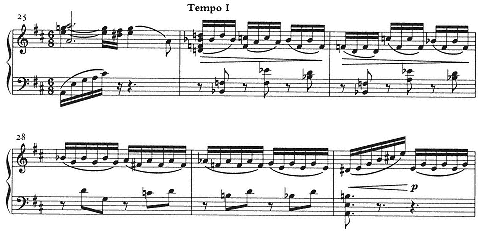
Example 3.5
Nicht doch! mm. 25–30 (piano part only).
gives way rather abruptly to a very different figuration oscillating between two notes a third apart. It is as if the upward-moving sixteenth-note figure has come to represent the kind of innocent, vernal love depicted in Mädchenfrühing, which gives way to the coarser, simpler sentiments of Nicht doch!
Mädchenfrühing and Nicht doch! also share certain tonal features, including a key signature of two sharps (also shared by the D-Major Quartet and Mädchenlied of the same year). Mädchenfrühiing is in B minor-major, Nicht doch! in D major. Although in the abstract this relationship could hardly be taken as evidence of harmonic planning, Schoenberg's treatment of D in the first song is suggestive. The D major sought but not reached in mm. 13–14 of Mädchenfrühiing (as discussed above) becomes the tonic of Nicht doch! —a relationship that becomes apparent only if the songs are performed together.
Although Nicht doch! is not as harmonically elegant as its companion song, one particular procedure points clearly to Schoenberg's growing control of large-scale tonal structure, control of a kind already discussed in the case of the contemporaneous D-Major String Quartet. The piano interlude that appears between strophes 1 and 2 (mm. 25–30; see ex. 3.5), and 2 and 3 (mm. 54–59), makes a sudden detour from the dominant seventh of D to the key of

During the first two strophes this harmonic diversion to the flatted sixth, the upper neighbor of the dominant, remains a detail confined to the interludes. But in the third strophe, Schoenberg picks up and expands the idea. Here the second quatrain ("Was denn. Kind?") begins not in the tonic, as in strophes 1 and 2, but
in iii (Appendix ex. J).



The two Dehmel songs of 1897 make a telling complement or sequel to the pair of Heyse settings. If the latter pair represent a saturation point of Schoenberg's Brahms absorption, the former two, especially Mädchenfrühiing, represent something of a new beginning. Had Schoenberg's encounter with the poetry of Dehmel been limited to these two works, we might not be inclined to see the poetry itself as initiating this new direction. But after a relatively fallow year in 1898, Schoenberg returned to Dehmel in 1899. The works of that year mark the real milestone in his early compositional development. This fact suggests that Dehmel's verse played a crucial role, one that must be examined further in the next two chapters.